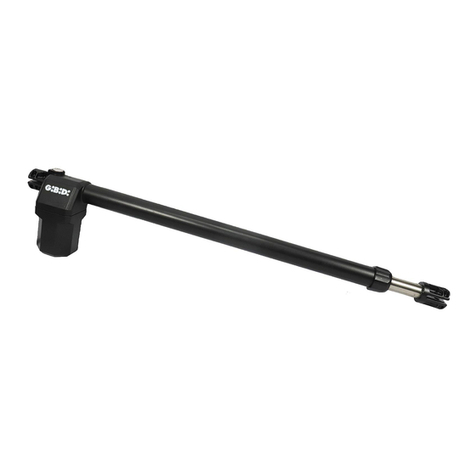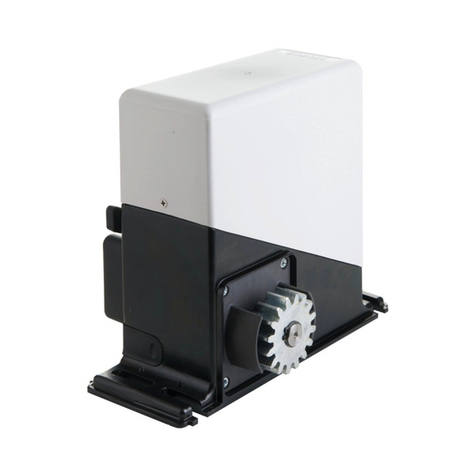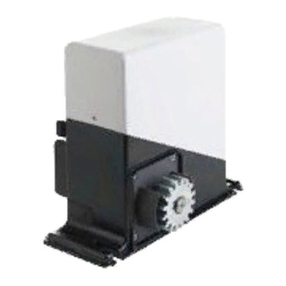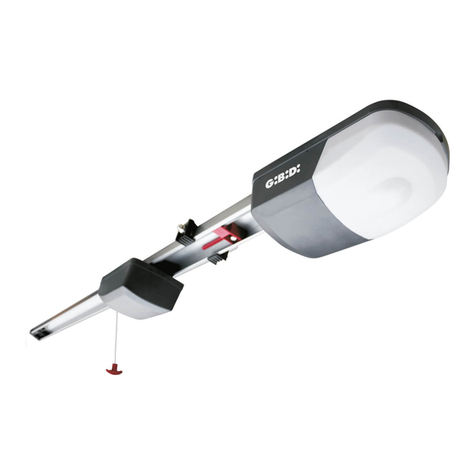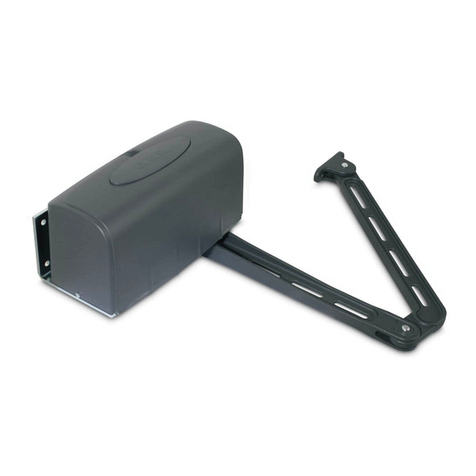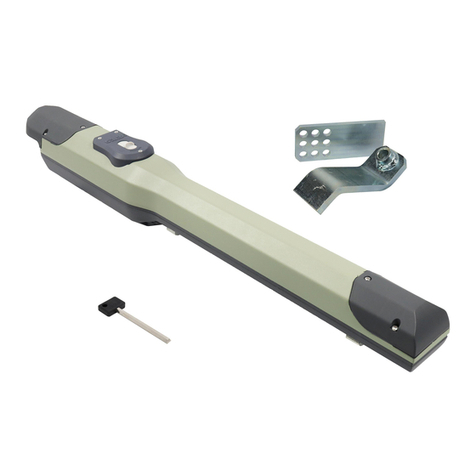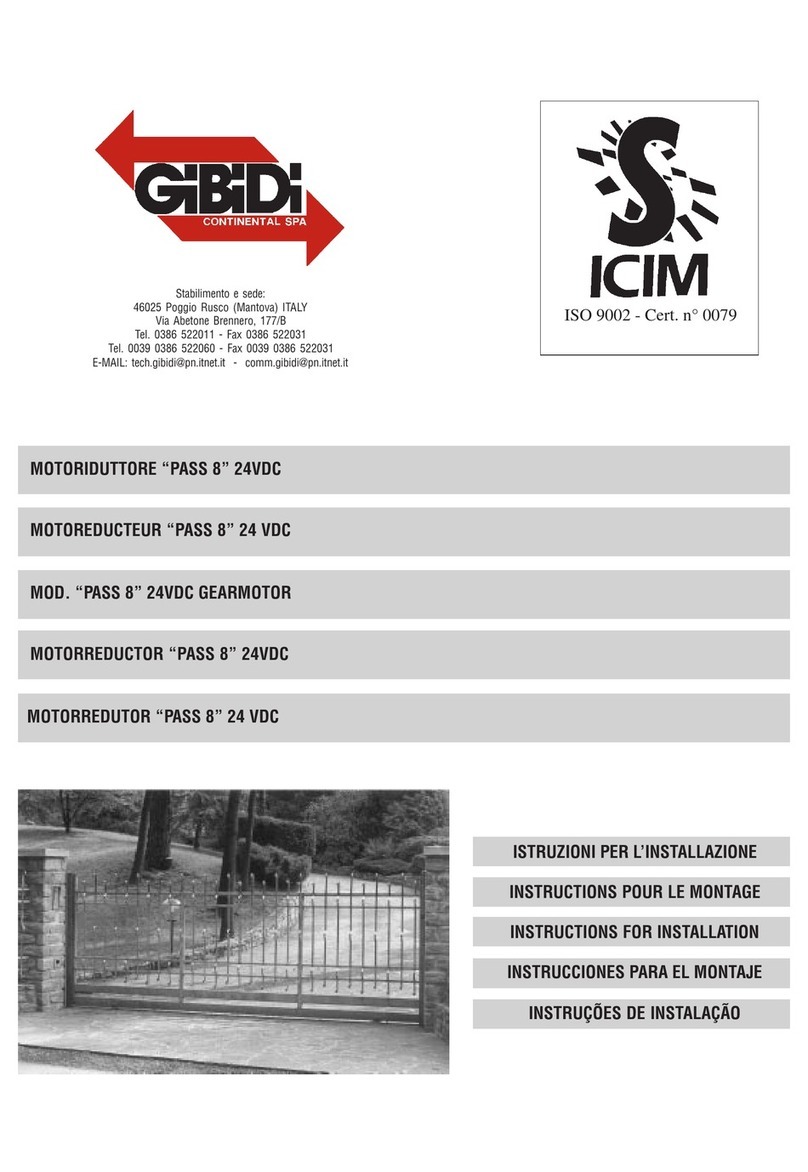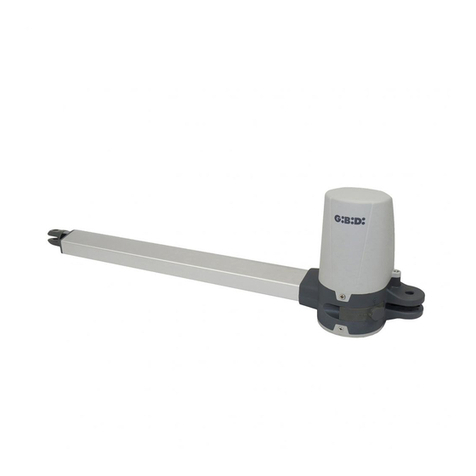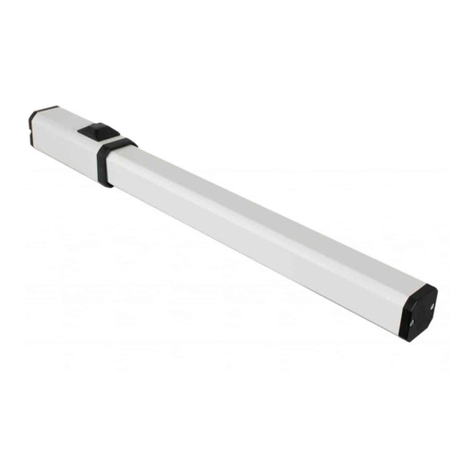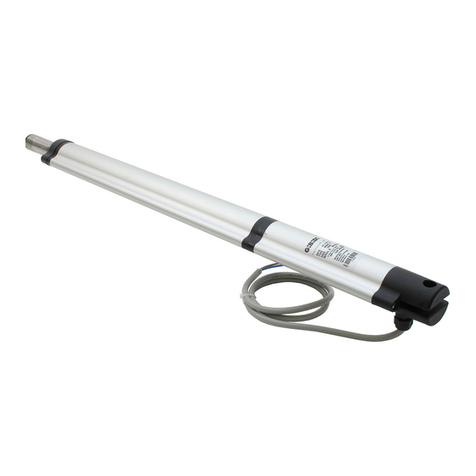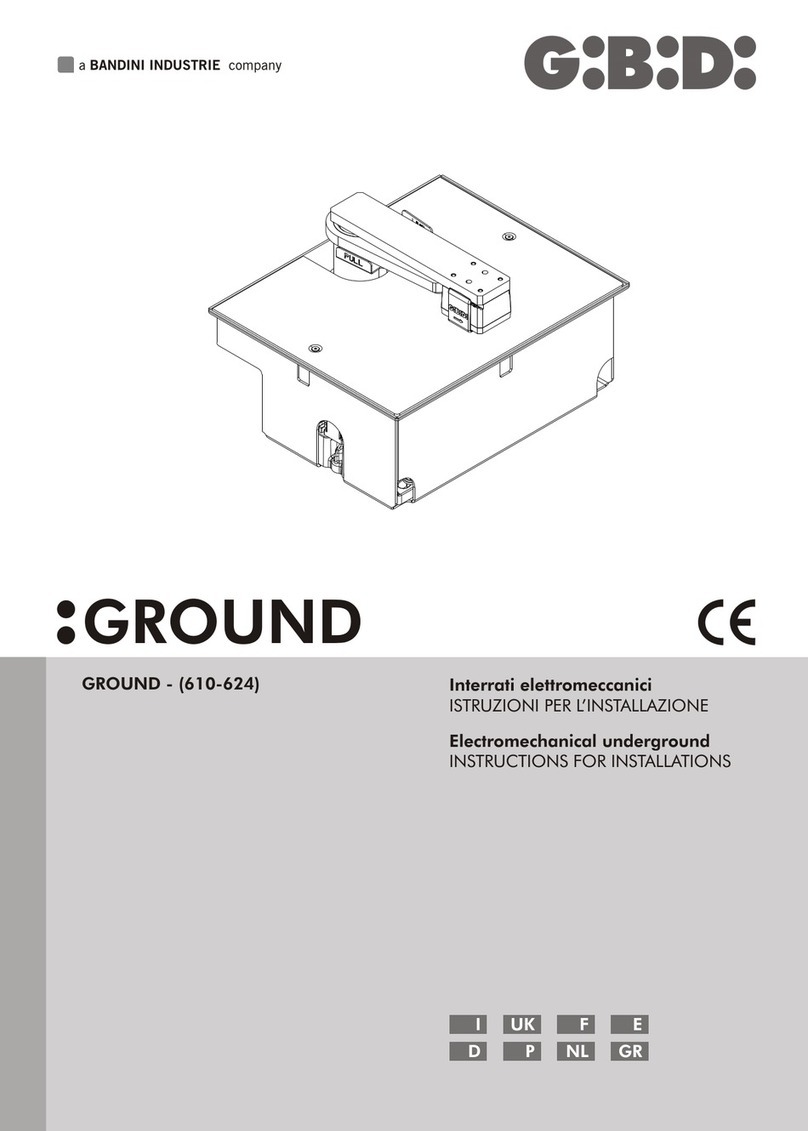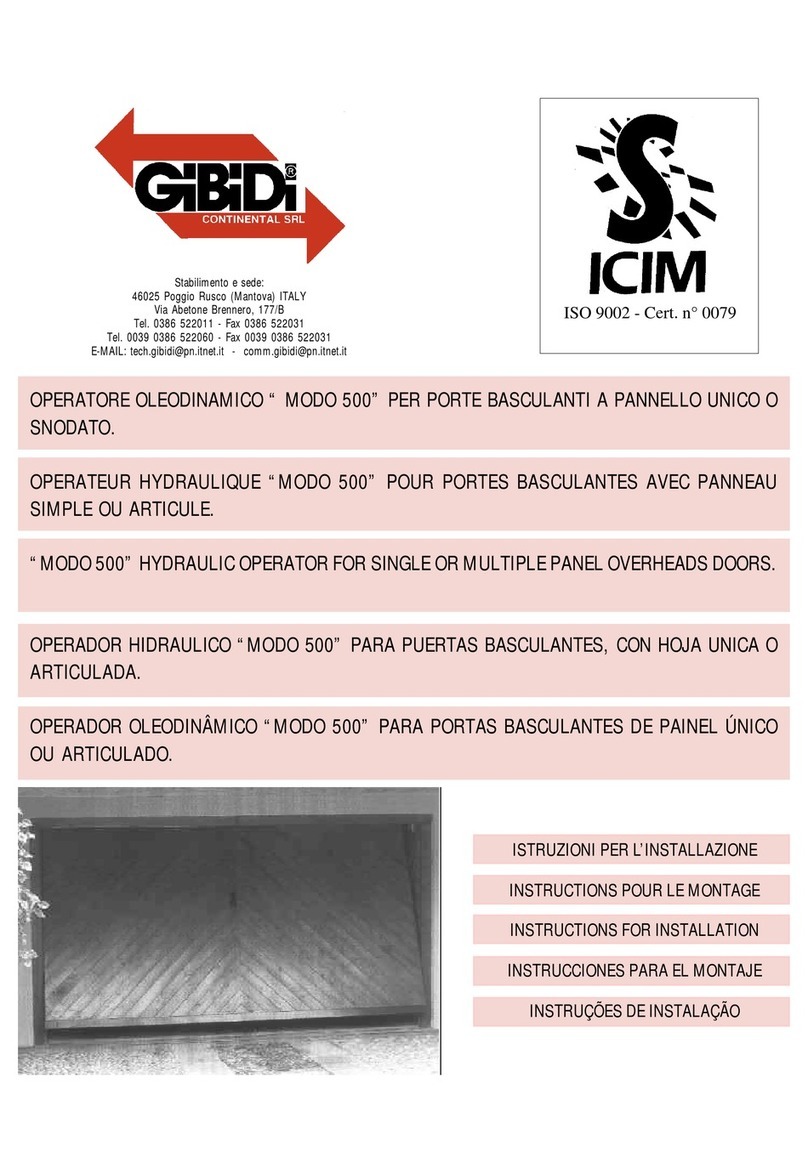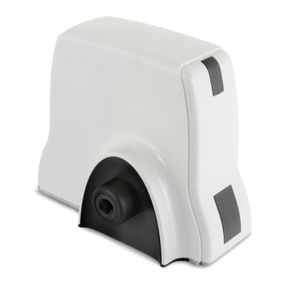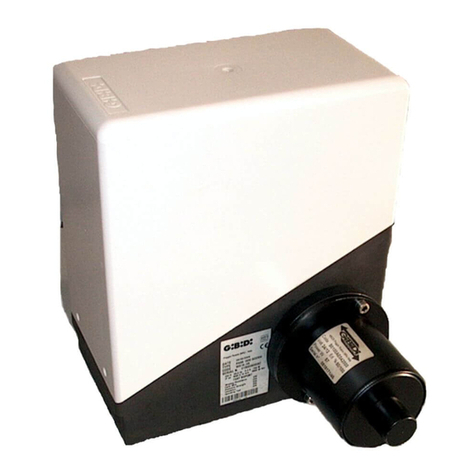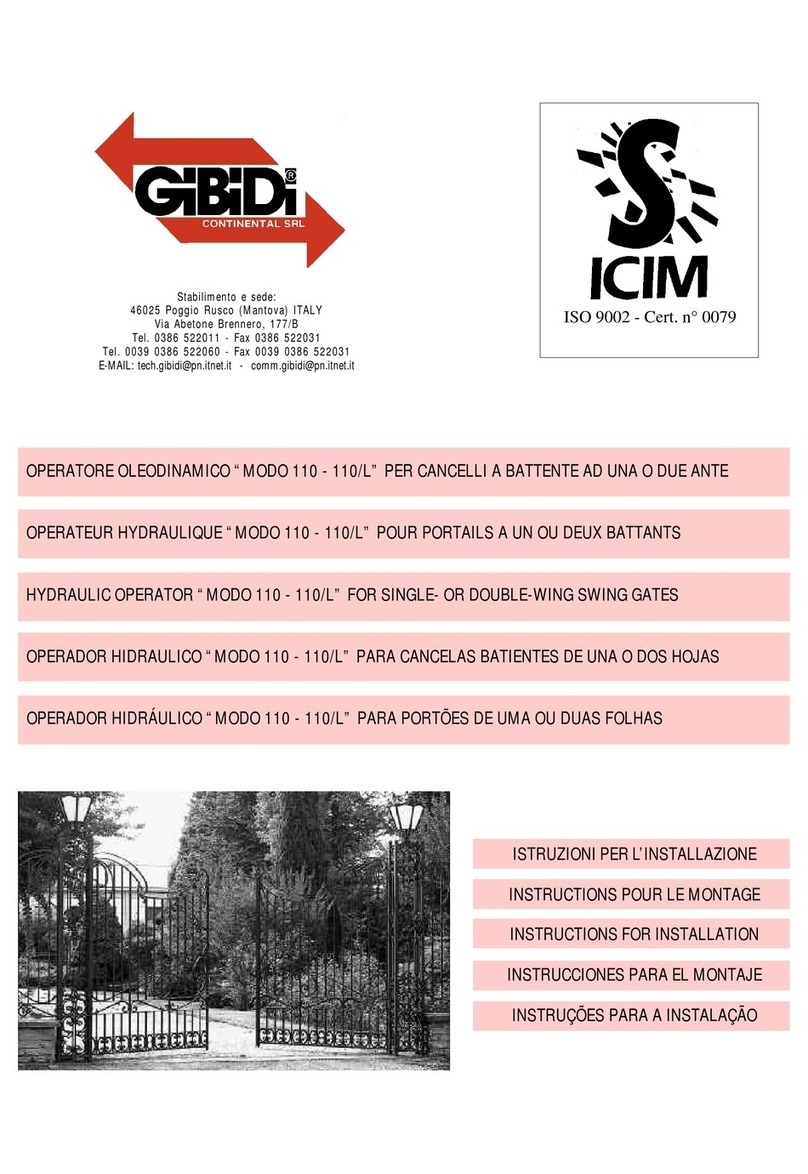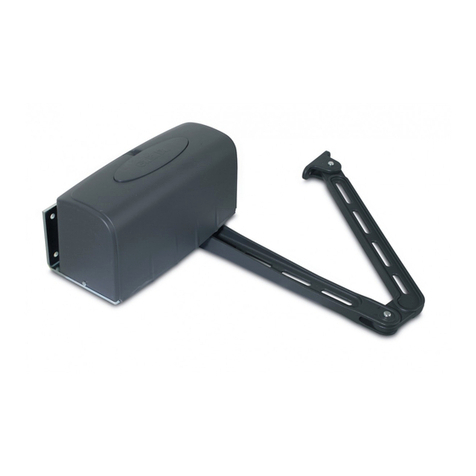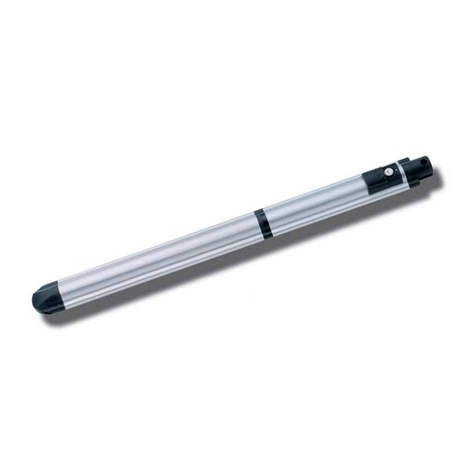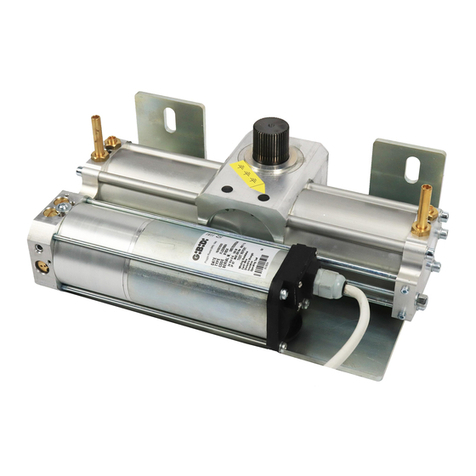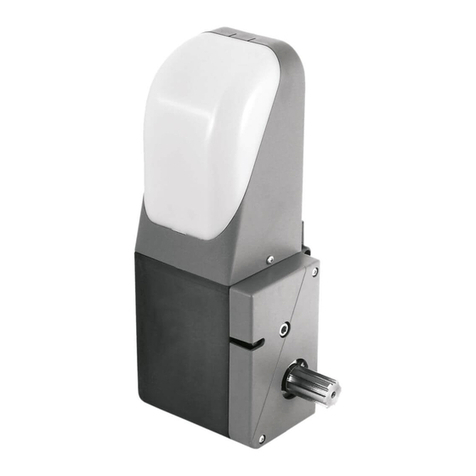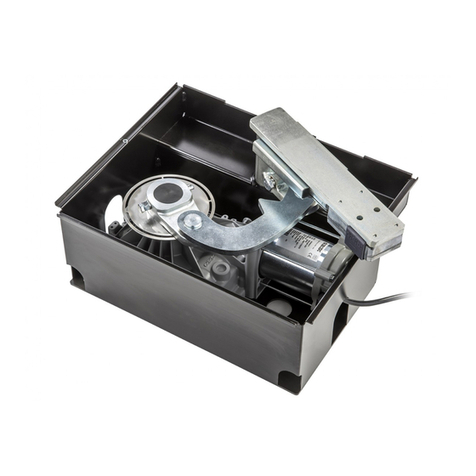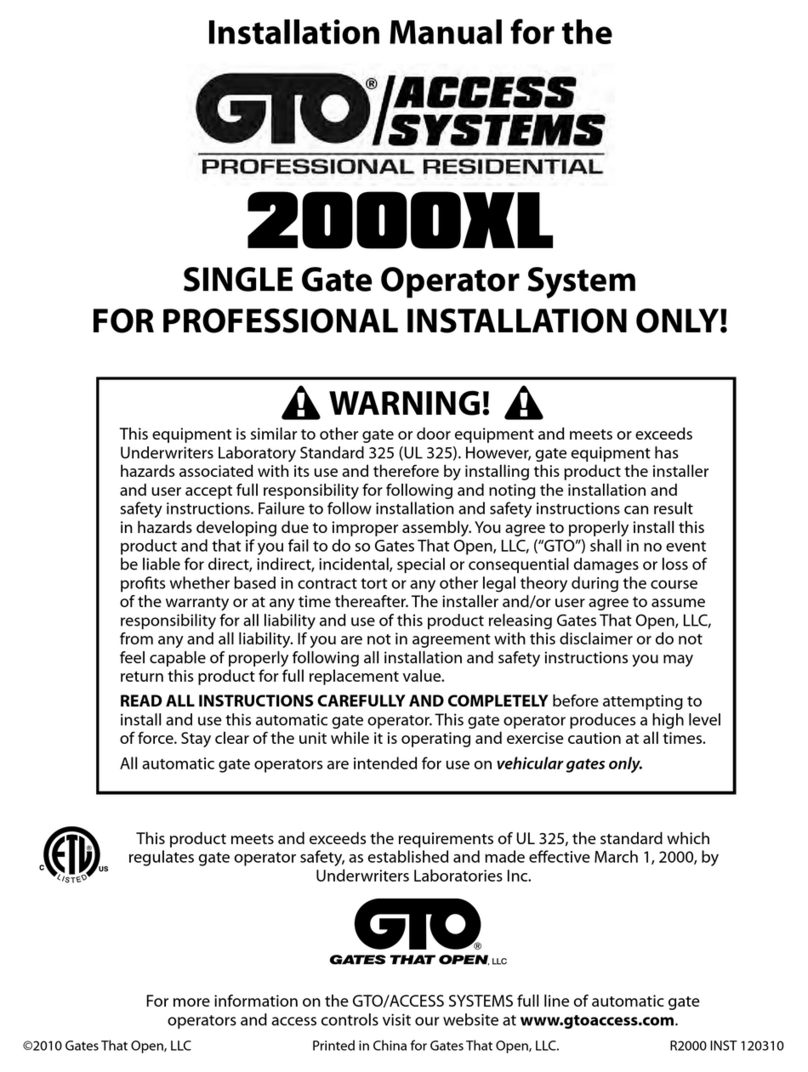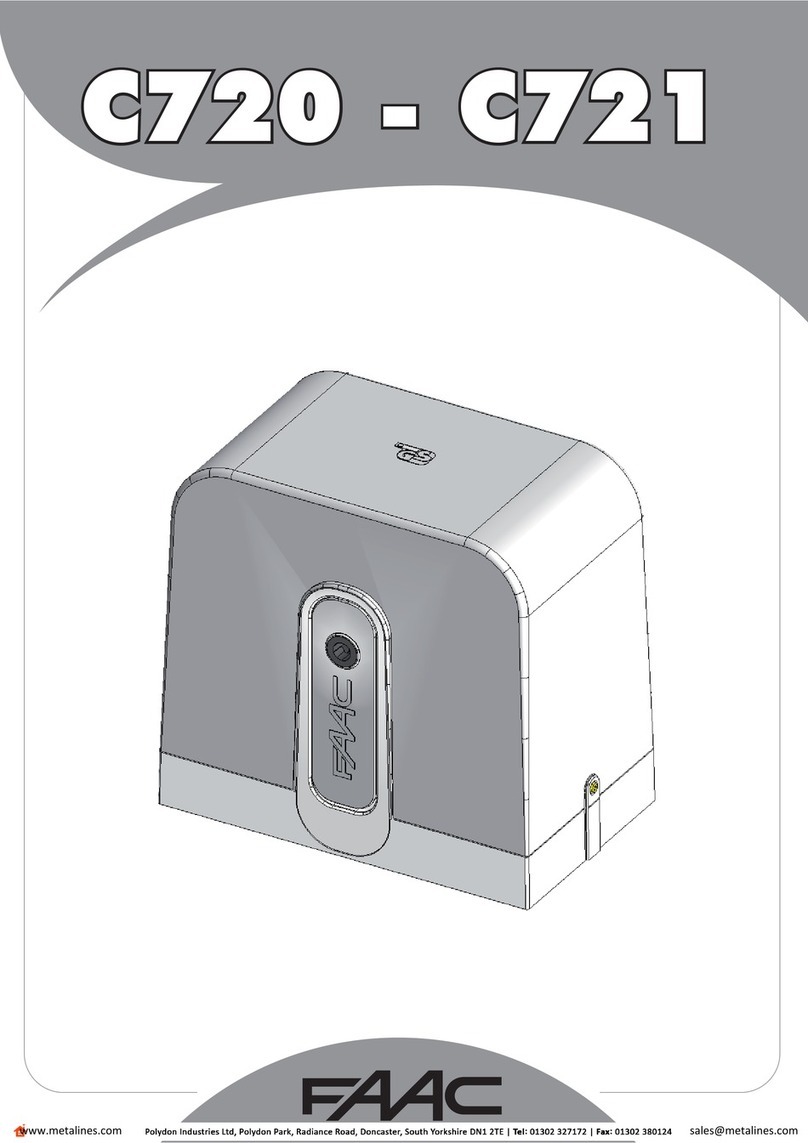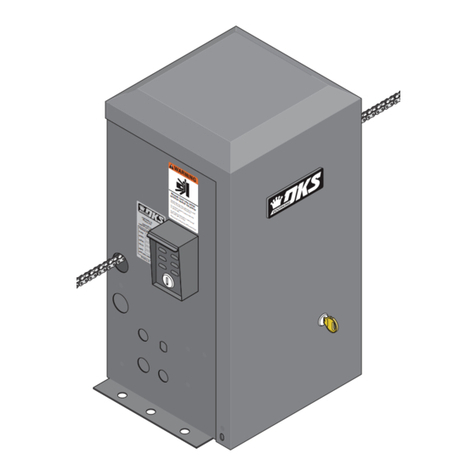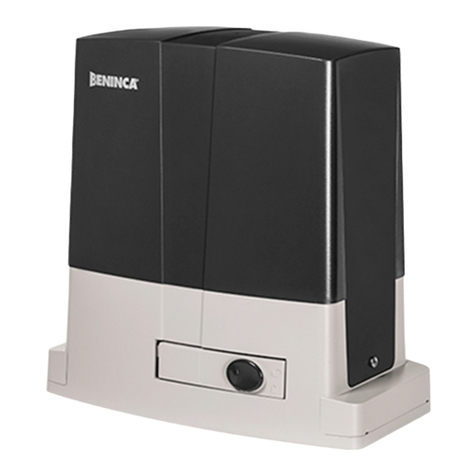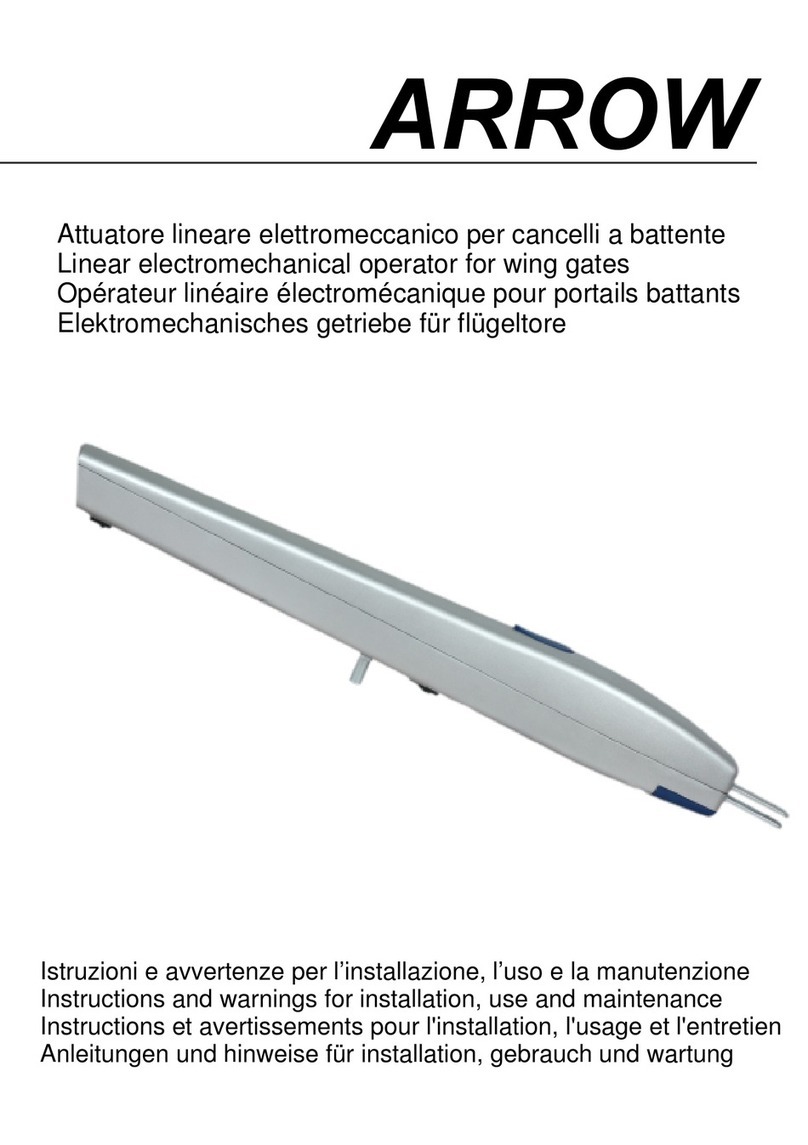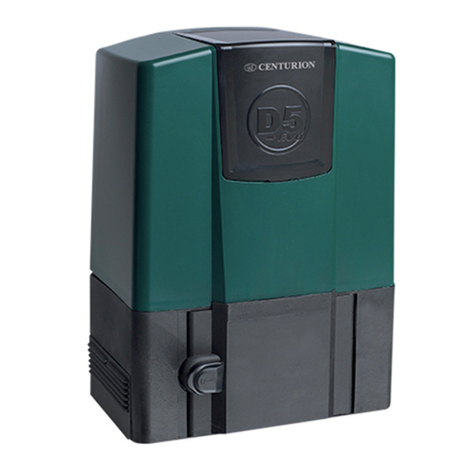GiBiDi PASS 1200 Guide

I UK
PASS
F E
Motoriduttori elettromeccanici
ISTRUZIONI PER L’INSTALLAZIONE
Irreversible electromechanical
INSTRUCTIONS FOR INSTALLATIONS
PASS (1200 - 1800 - 2500)
Motoréducteur électromécanique
INSTRUCTIONS POUR L’INSTALLATION
Motorreductor electromecánico
INSTRUCCIONES PARA LA INSTALACIÓN
Elektromechanische motorreductor
INSTRUCTIES VOOR DE INSTALLATIE
NL

2PASS 3
PASS
AVVERTENZA PER L'INSTALLAZIONE
PREMESSA
I motoriduttori della SERIE PASS 1200-1800-2500 permettono di automatizzare, facilmente e rapidamente, cancelli
scorrevoli di medie e grosse dimensioni fino a 2.500 Kg. Sono adatti per un uso condominiale e industriale.
Disponibili con o senza apparecchiatura di comando integrata, consentono una facile messa a norma degli impianti
secondo la normativa EN 12453.
ATTENZIONE: IMPORTANTI ISTRUZIONI DI SICUREZZA.
E' importante per la sicurezza delle persone seguire queste istruzioni.
Conservare il presente libretto di istruzioni.
Prima di procedere con l'installazione bisogna predisporre a monte dell'impianto un interruttore magneto termico
e differenziale con portata massima 10A. L'interruttore deve garantire una separazione omnipolare dei contatti,
con distanza di apertura di almeno 3mm.
Tutti i materiali presenti nell'imballo non devono essere lasciati alla portata dei bambini in quanto potenziali fonti di
pericolo.
Il costruttore declina ogni responsabilità ai fini del corretto funzionamento dell'automazione nel caso non
vengano utilizzati i componenti e gli accessori di propria produzione e idonei per l'applicazione prevista.
Al termine dell'installazione verificare sempre con attenzione il corretto funzionamento dell'impianto e dei
dispositivi utilizzati.
Questa manuale d'istruzione si rivolge a persone abilitate all'installazione di “ apparecchi sotto tensione “
pertanto si richiede una buona conoscenza della tecnica, esercitata come professione e nel rispetto delle norme
vigenti.
La manutenzione deve essere eseguita da personale qualificato.
Prima di eseguire qualsiasi operazione di pulizia o di manutenzione, scollegare l'apparecchiatura dalle rete di
alimentazione elettrica.
Questo prodotto e stato progettato e costruito esclusivamente per I'utilizzo indicato in questa documentazione.
Usi non indicati in questa documentazione potrebbero essere fonte di danni al prodotto e fonte di pericolo.
Verificare lo scopo dell'utilizzo finale e assicurarsi di prendere tutte le sicurezze necessarie.
L'utilizzo dei prodotti e la loro destinazione ad usi diversi da quelli previsti, non è stata sperimentata dal
costruttore, pertanto i lavori eseguiti sono sotto la completa responsabilità dell'installatore.
Segnalare l'automazione con targhe di avvertenza che devono essere visibili.
Avvisare l'utente che i bambini o animali non devono giocare o sostare nei pressi del cancello.
Proteggere adeguatamente i punti di pericolo per esempio mediante l'uso di una costa sensibile .
Verificare se I 'impianto di terra è realizzato correttamente: collegare tutte le parti metalliche della chiusura (porte,
cancelli, ecc.) e tutti i componenti dell'impianto provvisti di morsetto di terra.
Usare esclusivamente parti originali per qualsiasi manutenzione o riparazione.
Non eseguire alcuna modifica ai componenti dell'automazione se non espressamente autorizzata dalla Ditta.
PREDISPOSIZIONI ELETTRICHE [1]
DATI TECNICI
AVVERTENZE PRELIMINARI
Tensione di alimentazione
Potenza assorbita
Corrente assorbita
Termoprotezione
Condensatore di spunto
Velocità max
Coppia max
Temperatura d'esercizio
Grado di protezione
Peso Max anta
Operatore
Tipo
PASS 1200 PASS 1800
Motoriduttore elettromeccanico irreversibile
220/230Vac 50-60Hz
MAX 700W
MAX 3A
140°C
25µF
0,15 m/sec
50 Nm
-20°C + 60°C
IP 55
1200 Kg
60 Nm
-20°C + 60°C
IP 55
1800 Kg
MAX 700W
MAX 3A
PASS 2500
90 Nm
-20°C + 60°C
IP 55
2500 Kg
-
MAX 750W
MAX 3A
380Vac trifase
140°C 140°C
16µF
0,15 m/sec 0,15 m/sec
Olio GBD PH-02
A = Tempo di apertura
C = Tempo di chiusura
P = Tempo di pausa globale
A+C+P = Tempo che intercorre fra due
aperture
%Fu = x 100
A + C
A + C + P
Formula per il calcolo della
frequenza di utilizzo
[22]
1- Motoriduttore: alimentazione, cavo 3x1.5mm²(PASS1200-1800) - 4x1,5 (attenersi alle norme vigenti).
2- Trasmettitore fotocellula; cavo 2x0,5mm².
3- Ricevitore fotocellula; cavo 4x0,5 mm².
4- Antenna; cavo coassiale schermato.
5- Costa; cavo 4x0,5mm².
6- Cremagliera
7- Selettore a chiave; cavo 3x0,5mm².
8- Segnalatore a luce lampeggiante a 230Vac ; cavo 2x0,75mm².
9- Interruttore magnetotermico omnipolare con apertura minima dei contatti pari a 3mm. Linea di alimentazione
all'apparecchiatura: 220-230V 50-60Hz cavo 3x1.5mm²(PASS1200-1800) - x1,5mm²
(PASS2500) (attenersi alle norme vigenti).
mm² (PASS2500)
380V, 50-60Hz, cavo 5
Frequenza d'uso (%)
90% (a 20°C) 60% (a 20°C) 70% (a 20°C)
Verificare che la struttura del cancello sia conforme a quanto previsto dalle normative vigenti e che il movimento
dell'anta sia lineare e privo di attriti.
Verifiche preliminari:
Controllare che la struttura del cancello sia sufficientemente robusta. in ogni caso verificare che il cancello abbia
peso e dimensioni che rientrano nei limiti di impiego dell'operatore.
Controllare che l'anta si muova manualmente e senza sforzo (punti di maggiore attrito)per tutta la corsa del
cancello sia in apertura che in chiusura.
I I

2PASS 3
PASS
AVVERTENZA PER L'INSTALLAZIONE
PREMESSA
I motoriduttori della SERIE PASS 1200-1800-2500 permettono di automatizzare, facilmente e rapidamente, cancelli
scorrevoli di medie e grosse dimensioni fino a 2.500 Kg. Sono adatti per un uso condominiale e industriale.
Disponibili con o senza apparecchiatura di comando integrata, consentono una facile messa a norma degli impianti
secondo la normativa EN 12453.
ATTENZIONE: IMPORTANTI ISTRUZIONI DI SICUREZZA.
E' importante per la sicurezza delle persone seguire queste istruzioni.
Conservare il presente libretto di istruzioni.
Prima di procedere con l'installazione bisogna predisporre a monte dell'impianto un interruttore magneto termico
e differenziale con portata massima 10A. L'interruttore deve garantire una separazione omnipolare dei contatti,
con distanza di apertura di almeno 3mm.
Tutti i materiali presenti nell'imballo non devono essere lasciati alla portata dei bambini in quanto potenziali fonti di
pericolo.
Il costruttore declina ogni responsabilità ai fini del corretto funzionamento dell'automazione nel caso non
vengano utilizzati i componenti e gli accessori di propria produzione e idonei per l'applicazione prevista.
Al termine dell'installazione verificare sempre con attenzione il corretto funzionamento dell'impianto e dei
dispositivi utilizzati.
Questa manuale d'istruzione si rivolge a persone abilitate all'installazione di “ apparecchi sotto tensione “
pertanto si richiede una buona conoscenza della tecnica, esercitata come professione e nel rispetto delle norme
vigenti.
La manutenzione deve essere eseguita da personale qualificato.
Prima di eseguire qualsiasi operazione di pulizia o di manutenzione, scollegare l'apparecchiatura dalle rete di
alimentazione elettrica.
Questo prodotto e stato progettato e costruito esclusivamente per I'utilizzo indicato in questa documentazione.
Usi non indicati in questa documentazione potrebbero essere fonte di danni al prodotto e fonte di pericolo.
Verificare lo scopo dell'utilizzo finale e assicurarsi di prendere tutte le sicurezze necessarie.
L'utilizzo dei prodotti e la loro destinazione ad usi diversi da quelli previsti, non è stata sperimentata dal
costruttore, pertanto i lavori eseguiti sono sotto la completa responsabilità dell'installatore.
Segnalare l'automazione con targhe di avvertenza che devono essere visibili.
Avvisare l'utente che i bambini o animali non devono giocare o sostare nei pressi del cancello.
Proteggere adeguatamente i punti di pericolo per esempio mediante l'uso di una costa sensibile .
Verificare se I 'impianto di terra è realizzato correttamente: collegare tutte le parti metalliche della chiusura (porte,
cancelli, ecc.) e tutti i componenti dell'impianto provvisti di morsetto di terra.
Usare esclusivamente parti originali per qualsiasi manutenzione o riparazione.
Non eseguire alcuna modifica ai componenti dell'automazione se non espressamente autorizzata dalla Ditta.
PREDISPOSIZIONI ELETTRICHE [1]
DATI TECNICI
AVVERTENZE PRELIMINARI
Tensione di alimentazione
Potenza assorbita
Corrente assorbita
Termoprotezione
Condensatore di spunto
Velocità max
Coppia max
Temperatura d'esercizio
Grado di protezione
Peso Max anta
Operatore
Tipo
PASS 1200 PASS 1800
Motoriduttore elettromeccanico irreversibile
220/230Vac 50-60Hz
MAX 700W
MAX 3A
140°C
25µF
0,15 m/sec
50 Nm
-20°C + 60°C
IP 55
1200 Kg
60 Nm
-20°C + 60°C
IP 55
1800 Kg
MAX 700W
MAX 3A
PASS 2500
90 Nm
-20°C + 60°C
IP 55
2500 Kg
-
MAX 750W
MAX 3A
380Vac trifase
140°C 140°C
16µF
0,15 m/sec 0,15 m/sec
Olio GBD PH-02
A = Tempo di apertura
C = Tempo di chiusura
P = Tempo di pausa globale
A+C+P = Tempo che intercorre fra due
aperture
%Fu = x 100
A + C
A + C + P
Formula per il calcolo della
frequenza di utilizzo
[22]
1- Motoriduttore: alimentazione, cavo 3x1.5mm²(PASS1200-1800) - 4x1,5 (attenersi alle norme vigenti).
2- Trasmettitore fotocellula; cavo 2x0,5mm².
3- Ricevitore fotocellula; cavo 4x0,5 mm².
4- Antenna; cavo coassiale schermato.
5- Costa; cavo 4x0,5mm².
6- Cremagliera
7- Selettore a chiave; cavo 3x0,5mm².
8- Segnalatore a luce lampeggiante a 230Vac ; cavo 2x0,75mm².
9- Interruttore magnetotermico omnipolare con apertura minima dei contatti pari a 3mm. Linea di alimentazione
all'apparecchiatura: 220-230V 50-60Hz cavo 3x1.5mm²(PASS1200-1800) - x1,5mm²
(PASS2500) (attenersi alle norme vigenti).
mm² (PASS2500)
380V, 50-60Hz, cavo 5
Frequenza d'uso (%)
90% (a 20°C) 60% (a 20°C) 70% (a 20°C)
Verificare che la struttura del cancello sia conforme a quanto previsto dalle normative vigenti e che il movimento
dell'anta sia lineare e privo di attriti.
Verifiche preliminari:
Controllare che la struttura del cancello sia sufficientemente robusta. in ogni caso verificare che il cancello abbia
peso e dimensioni che rientrano nei limiti di impiego dell'operatore.
Controllare che l'anta si muova manualmente e senza sforzo (punti di maggiore attrito)per tutta la corsa del
cancello sia in apertura che in chiusura.
I I

4PASS 5
PASS
I I
INSTALLAZIONE DEL MOTORIDUTTORE
MONTAGGIO DELLA CREMAGLIERA
MURATURA DELLA PIASTRA
1- Applicare le staffe di fissaggio [6] e togliere il cofano del motoriduttore svitando le viti laterali [7];
2- Posizionare il motoriduttore sulla piastra di fondazione facendo passare i perni nelle apposite asole [8];
3- Tenere il motoriduttore alzato di 2/4mm per poi abbassarlo dopo aver ultimato il fissaggio della cremagliera [9a-
9b];
4- Avvitare i 4 dadi per fissare il motoriduttore parallelo al cancello [9a-9b];
1- Eseguire lo scavo per la piastra di fondazione rispettando le quote [2], disponendo la piastra secondo il senso di
chiusura del cancello [4], e ricordando che lo scavo deve essere di una profondità almeno pari alla lunghezza
delle zanche [5].
2- Far giungere i tubi flessibili per il passaggio dei cavi elettrici facendo attenzione alla posizione di uscita dalla
piastra degli stessi [4], lasciando che il tubo sporga dal foro della piastra di circa 30 - 40 mm [5].
3- Assicurarsi che la piastra sia a livello [5] e cominciare a riempire lo scavo con la gettata di calcestruzzo.
4- Attendere l'indurimento del cemento all'interno dello scavo.
5- Far passare i cavi elettrici (collegamento accessori e alimentazione elettrica) all'interno dei tubi flessibili.
Per una maggiore maneggevolezza dei collegamenti elettrici con l'apparecchiatura si consiglia di tenere una
lunghezza dei cavi pari a 400mm dal foro della piastra di fondazione [5].
1- Portare manualmente il cancello in posizione di chiusura;
2- Sbloccare il motoriduttore (vedi paragrafo dispositivo di sblocco);
3- Predisporre la cremagliera (opzionale)[10 - 11 - 12];
4- Appoggiare sul pignone il primo elemento della cremagliera in modo che sporga di 50 mm dal motoriduttore [13]
per lasciare lo spazio necessario alla staffa del finecorsa;
5- Fissare l'elemento con la vite nell'apposita asola o distanziale in base al tipo di cremagliera scelto [10 - 11 - 12]. Si
consiglia di stringere le viti di fissaggio della cremagliera nella parte superiore dell'asola, in modo da poterla alzare
e mantenere il necessario gioco fra pignone e cremagliera in caso di abbassamento del cancello;
6- Continuare con il montaggio della cremagliera allineando i moduli uno dopo l'altro, ricordando che per fissare I
moduli correttamente bisogna utilizzare un pezzo di cremagliera di circa 150 mm per mettere in fase la dentatura
[14]. Una volta fissato l'ultimo modulo provvedere a tagliare con un seghetto la parte sporgente.
7- Finito di montare tutti i moduli effettuare manualmente alcune manovre di apertura e chiusura del cancello per
verificare che l'anta scorra libera e priva di attriti;
8- Abbassare l'operatore e bloccarlo lasciando un gioco di 2 mm fra pignone e cremagliera [15], per far si che il
peso del cancello non influisca negativamente sull'albero del motoriduttore.
Controllare che la zona dove verrà fissato il motoriduttore non sia esposta ad allagamenti. Se così fosse installare
il motoriduttore sollevato da terra.
Se il cancello non è di nuova installazione controllare lo stato di usura di tutti i componenti, sistemare o sostituire le
parti difettose o usurate e, se necessario, effettuare gli opportuni interventi.
Prevedere l’utilizzo di finecorsa meccanici per gestire le situazioni di extra corsa dell’anta.
L'affidabilità e la sicurezza dell'automazione, è direttamente influenzata dallo stato della struttura del cancello.
MONTAGGIO DEI FINECORSA [16]
UTILIZZO DEI RALLENTAMENTI
1- Inserire i dadi u nelle apposite sedi a cava esagonale nel portamagnete p;
2- Inserire il grano e dado q all'interno del portamagnete p avendo cura che questo sporga verso la cremagliera w
di almeno 1-1.5 mm;
3- Inserire la vite di regolazione e dado y nella cava esagonale del portamagnete p;
4- Assemblare la staffa e mediante le viti a corredo r ed infilare i grani t.
NOTA: in questa fase è sufficiente assemblare il gruppo per poi poterlo collocare sulla cremagliera, senza bisogno di
serrare le viti.
5- Posizionare i finecorsa completi sulla cremagliera nelle posizioni opportune.
NOTA: il finecorsa contrassegnato sul coperchio con la lettera “O” deve essere fissato in corrispondenza della
posizione di cancello aperto; quello contrassegnato con la lettera “C” deve essere fissato in corrispondenza della
posizione di cancello chiuso [19]. Per far si che questa condizione sia vera nel tipo di applicazione con motore
installato a “sinistra” [19] invertire i cavi di alimentazione motore.
Nota di riferimento figura [19]
C2: Finecorsa “C” Fermo motore in chiusura
C1: Finecorsa “C” Inizio rallentamento in chiusura
O2: Finecorsa “O” Fermo motore in apertura
O1: Finecorsa “O” Inizio rallentamento in apertura
6- Per fissare il finecorsa è necessario serrare prima le due viti r, poi agire sulla vite y per regolare la distanza del
morsetto al variare della tipologia di cremagliera in seguito agire sui grani t al fine di bloccare stabilmente la
staffa alla cremagliera .
ATTENZIONE: serrare i grani in t senza giungere alla deformazione della staffa
7- Qualora il finecorsa non sia ancora sufficientemente solidale con la cremagliera è possibile agire svitando la vite iny.
ATTENZIONE: non eccedere con questa registrazione in quanto potrebbe causare la deformazione della staffa .
In caso di utilizzo di schede GI.BI.DI. aventi la funzione di gestione dei rallentamenti ricordare di posizionare 2 coppie
di finecorsa [19].
ATTENZIONE: Prima di iniziare la regolazione della coppia togliere tensione tramite l’interruttore generale di linea.
Inserire la chiave a brugola r da sei mm nella sede w tenendo presente che ruotando la chiave in senso orario
la forza di spinta aumenta, ruotandola in senso antiorario diminuisce.
Nel caso che ruotando la chiave a brugola ruoti anche l’albero, far combaciare le due sedi q, quella sull’albero
con quella sulla flangia, quindi inserire un cacciavite e e con la chiave a brugola regolare la frizione.
Ÿ
Ÿ
REGOLAZIONE DELLA COPPIA [20]

4PASS 5
PASS
I I
INSTALLAZIONE DEL MOTORIDUTTORE
MONTAGGIO DELLA CREMAGLIERA
MURATURA DELLA PIASTRA
1- Applicare le staffe di fissaggio [6] e togliere il cofano del motoriduttore svitando le viti laterali [7];
2- Posizionare il motoriduttore sulla piastra di fondazione facendo passare i perni nelle apposite asole [8];
3- Tenere il motoriduttore alzato di 2/4mm per poi abbassarlo dopo aver ultimato il fissaggio della cremagliera [9a-
9b];
4- Avvitare i 4 dadi per fissare il motoriduttore parallelo al cancello [9a-9b];
1- Eseguire lo scavo per la piastra di fondazione rispettando le quote [2], disponendo la piastra secondo il senso di
chiusura del cancello [4], e ricordando che lo scavo deve essere di una profondità almeno pari alla lunghezza
delle zanche [5].
2- Far giungere i tubi flessibili per il passaggio dei cavi elettrici facendo attenzione alla posizione di uscita dalla
piastra degli stessi [4], lasciando che il tubo sporga dal foro della piastra di circa 30 - 40 mm [5].
3- Assicurarsi che la piastra sia a livello [5] e cominciare a riempire lo scavo con la gettata di calcestruzzo.
4- Attendere l'indurimento del cemento all'interno dello scavo.
5- Far passare i cavi elettrici (collegamento accessori e alimentazione elettrica) all'interno dei tubi flessibili.
Per una maggiore maneggevolezza dei collegamenti elettrici con l'apparecchiatura si consiglia di tenere una
lunghezza dei cavi pari a 400mm dal foro della piastra di fondazione [5].
1- Portare manualmente il cancello in posizione di chiusura;
2- Sbloccare il motoriduttore (vedi paragrafo dispositivo di sblocco);
3- Predisporre la cremagliera (opzionale)[10 - 11 - 12];
4- Appoggiare sul pignone il primo elemento della cremagliera in modo che sporga di 50 mm dal motoriduttore [13]
per lasciare lo spazio necessario alla staffa del finecorsa;
5- Fissare l'elemento con la vite nell'apposita asola o distanziale in base al tipo di cremagliera scelto [10 - 11 - 12]. Si
consiglia di stringere le viti di fissaggio della cremagliera nella parte superiore dell'asola, in modo da poterla alzare
e mantenere il necessario gioco fra pignone e cremagliera in caso di abbassamento del cancello;
6- Continuare con il montaggio della cremagliera allineando i moduli uno dopo l'altro, ricordando che per fissare I
moduli correttamente bisogna utilizzare un pezzo di cremagliera di circa 150 mm per mettere in fase la dentatura
[14]. Una volta fissato l'ultimo modulo provvedere a tagliare con un seghetto la parte sporgente.
7- Finito di montare tutti i moduli effettuare manualmente alcune manovre di apertura e chiusura del cancello per
verificare che l'anta scorra libera e priva di attriti;
8- Abbassare l'operatore e bloccarlo lasciando un gioco di 2 mm fra pignone e cremagliera [15], per far si che il
peso del cancello non influisca negativamente sull'albero del motoriduttore.
Controllare che la zona dove verrà fissato il motoriduttore non sia esposta ad allagamenti. Se così fosse installare
il motoriduttore sollevato da terra.
Se il cancello non è di nuova installazione controllare lo stato di usura di tutti i componenti, sistemare o sostituire le
parti difettose o usurate e, se necessario, effettuare gli opportuni interventi.
Prevedere l’utilizzo di finecorsa meccanici per gestire le situazioni di extra corsa dell’anta.
L'affidabilità e la sicurezza dell'automazione, è direttamente influenzata dallo stato della struttura del cancello.
MONTAGGIO DEI FINECORSA [16]
UTILIZZO DEI RALLENTAMENTI
1- Inserire i dadi u nelle apposite sedi a cava esagonale nel portamagnete p;
2- Inserire il grano e dado q all'interno del portamagnete p avendo cura che questo sporga verso la cremagliera w
di almeno 1-1.5 mm;
3- Inserire la vite di regolazione e dado y nella cava esagonale del portamagnete p;
4- Assemblare la staffa e mediante le viti a corredo r ed infilare i grani t.
NOTA: in questa fase è sufficiente assemblare il gruppo per poi poterlo collocare sulla cremagliera, senza bisogno di
serrare le viti.
5- Posizionare i finecorsa completi sulla cremagliera nelle posizioni opportune.
NOTA: il finecorsa contrassegnato sul coperchio con la lettera “O” deve essere fissato in corrispondenza della
posizione di cancello aperto; quello contrassegnato con la lettera “C” deve essere fissato in corrispondenza della
posizione di cancello chiuso [19]. Per far si che questa condizione sia vera nel tipo di applicazione con motore
installato a “sinistra” [19] invertire i cavi di alimentazione motore.
Nota di riferimento figura [19]
C2: Finecorsa “C” Fermo motore in chiusura
C1: Finecorsa “C” Inizio rallentamento in chiusura
O2: Finecorsa “O” Fermo motore in apertura
O1: Finecorsa “O” Inizio rallentamento in apertura
6- Per fissare il finecorsa è necessario serrare prima le due viti r, poi agire sulla vite y per regolare la distanza del
morsetto al variare della tipologia di cremagliera in seguito agire sui grani t al fine di bloccare stabilmente la
staffa alla cremagliera .
ATTENZIONE: serrare i grani in t senza giungere alla deformazione della staffa
7- Qualora il finecorsa non sia ancora sufficientemente solidale con la cremagliera è possibile agire svitando la vite iny.
ATTENZIONE: non eccedere con questa registrazione in quanto potrebbe causare la deformazione della staffa .
In caso di utilizzo di schede GI.BI.DI. aventi la funzione di gestione dei rallentamenti ricordare di posizionare 2 coppie
di finecorsa [19].
ATTENZIONE: Prima di iniziare la regolazione della coppia togliere tensione tramite l’interruttore generale di linea.
Inserire la chiave a brugola r da sei mm nella sede w tenendo presente che ruotando la chiave in senso orario
la forza di spinta aumenta, ruotandola in senso antiorario diminuisce.
Nel caso che ruotando la chiave a brugola ruoti anche l’albero, far combaciare le due sedi q, quella sull’albero
con quella sulla flangia, quindi inserire un cacciavite e e con la chiave a brugola regolare la frizione.
Ÿ
Ÿ
REGOLAZIONE DELLA COPPIA [20]

6PASS 7
PASS
I I
MANOVRA MANUALE [21]
VERIFICHE FINALI
MANUTENZIONE
In caso di guasto o di mancanza di corrente, per la manovra manuale:
Ruotare il coperchietto r, inserire la chiave e e ruotarla in senso orario, verso destra, senza forzarla. La chiave
e uscirà di alcuni millimetri spinta da una molla.
Agire sulla maniglia q e ruotarla completamente di 180° verso sinistra; a questo punto si può aprire e chiudere il
cancello manualmente.
Per il ripristino in automatico ruotare la maniglia q nella posizione iniziale, spingere la chiave e in avanti,
ruotarla in senso antiorario, verso sinistra, quindi estrarla.:
N.B.: Se la chiave e non è spinta completamente in avanti, la stessa non ruota e non può essere estratta.
La maniglia q può essere bloccata agendo come sopra sulla chiave e anche in posizione di manovra
manuale.
Ÿ
Ÿ
Ÿ
Chiudere il cofano del motoriduttore. Alimentare l'impianto ed eseguire un ciclo completo di apertura e chiusura
verificando:
il Movimento regolare dell' anta;
il corretto funzionamento dei dispositivi di sicurezza;
la buona tenuta della piastra di fondazione;
che l'insieme del cancello sia conforme alle normative vigenti EN 12453 EN 12445;
Per maggiori dettagli e informazioni sulle normative di riferimento potete collegarvi al sito internet: www.gibidi.com
Si raccomanda di eseguire controlli periodici della struttura del cancello ed in particolare:
verificare la perfetta funzionalità delle guide;
verificare che la cremagliera, con il peso del cancello, non si sia abbassata in quanto andrebbe a gravare
sull'albero del motoriduttore. Se cosi fosse, alzare la cremagliera e stringere nuovamente le viti in un punto più
basso dell'asola o abbassare il motoriduttore con gli appositi dadi regolatori [9b];
verificare il buon funzionamento dei dispositivi di sicurezza ogni 6 mesi;
sbloccare l'operatore e verificare l'assenza di punti di attrito durante l'intera corsa;
verificare il corretto funzionamento del dispositivo di sblocco (vedi paragrafo relativo);
verificare che non ci sia sporco o detriti sul pignone;
Gi.Bi.Di. Srl. Si riserva la facoltà di modificare i dati tecnici senza avviso, in funzione dell'evoluzione del prodotto.
Cesoiamento
Schiacciamento
Impatto
Convogliamento Taglio Uncinamento
MESSA NORMA DELL’IMPIANTO
Quando una porta/cancello esistente
costruttore, è responsabile della sicurezza dell’impianto automatizzato e deve osservare le disposizioni previste
dalla Direttiva Macchine 2006/42/CE e dalla norma di prodotto EN13241-1.
viene automatizzata diventa una macchina, l’installatore assume il ruolo di
ZONE DI RISCHIO DEL CANCELLO SCORREVOLE
B
D
A
C
E
F
A B C
F
E
D

6PASS 7
PASS
I I
MANOVRA MANUALE [21]
VERIFICHE FINALI
MANUTENZIONE
In caso di guasto o di mancanza di corrente, per la manovra manuale:
Ruotare il coperchietto r, inserire la chiave e e ruotarla in senso orario, verso destra, senza forzarla. La chiave
e uscirà di alcuni millimetri spinta da una molla.
Agire sulla maniglia q e ruotarla completamente di 180° verso sinistra; a questo punto si può aprire e chiudere il
cancello manualmente.
Per il ripristino in automatico ruotare la maniglia q nella posizione iniziale, spingere la chiave e in avanti,
ruotarla in senso antiorario, verso sinistra, quindi estrarla.:
N.B.: Se la chiave e non è spinta completamente in avanti, la stessa non ruota e non può essere estratta.
La maniglia q può essere bloccata agendo come sopra sulla chiave e anche in posizione di manovra
manuale.
Ÿ
Ÿ
Ÿ
Chiudere il cofano del motoriduttore. Alimentare l'impianto ed eseguire un ciclo completo di apertura e chiusura
verificando:
il Movimento regolare dell' anta;
il corretto funzionamento dei dispositivi di sicurezza;
la buona tenuta della piastra di fondazione;
che l'insieme del cancello sia conforme alle normative vigenti EN 12453 EN 12445;
Per maggiori dettagli e informazioni sulle normative di riferimento potete collegarvi al sito internet: www.gibidi.com
Si raccomanda di eseguire controlli periodici della struttura del cancello ed in particolare:
verificare la perfetta funzionalità delle guide;
verificare che la cremagliera, con il peso del cancello, non si sia abbassata in quanto andrebbe a gravare
sull'albero del motoriduttore. Se cosi fosse, alzare la cremagliera e stringere nuovamente le viti in un punto più
basso dell'asola o abbassare il motoriduttore con gli appositi dadi regolatori [9b];
verificare il buon funzionamento dei dispositivi di sicurezza ogni 6 mesi;
sbloccare l'operatore e verificare l'assenza di punti di attrito durante l'intera corsa;
verificare il corretto funzionamento del dispositivo di sblocco (vedi paragrafo relativo);
verificare che non ci sia sporco o detriti sul pignone;
Gi.Bi.Di. Srl. Si riserva la facoltà di modificare i dati tecnici senza avviso, in funzione dell'evoluzione del prodotto.
Cesoiamento
Schiacciamento
Impatto
Convogliamento Taglio Uncinamento
MESSA NORMA DELL’IMPIANTO
Quando una porta/cancello esistente
costruttore, è responsabile della sicurezza dell’impianto automatizzato e deve osservare le disposizioni previste
dalla Direttiva Macchine 2006/42/CE e dalla norma di prodotto EN13241-1.
viene automatizzata diventa una macchina, l’installatore assume il ruolo di
ZONE DI RISCHIO DEL CANCELLO SCORREVOLE
B
D
A
C
E
F
A B C
F
E
D

MANUTENZIONE PERIODICA A CURA DI UN TECNICO SPECIALIZZATO
Data Annotazioni Firma Tecnico
Timbro ditta installatrice:
Data:
Firma tecnico:
Data Annotazioni Firma Tecnico
Timbro ditta installatrice:
Data:
Firma tecnico:
Verificare periodicamente il funzionamento delle sicurezze, non usare se stessi o altre persone per eseguire le
verifiche, sempre e solo oggetti.
Verificare periodicamente che la struttra del cancello, cerniere e guide non presentino evidenti segni di
cedimento o instabilità.
Togliere tensione all’impianto e verificare il corretto funzionamento del dispositivo di sblocco.
AVVERTENZE PER L'UTENTE
MANUTENZIONE ORDINARIA A CURA DELL’UTENTE
Data Annotazioni Firma
In caso di guasto o anomalie di funzionamento staccare l'alimentazione a monte dell'apparecchiatura e chiamare
l’assistenza tecnica.
Non permettere a persone o cose di sostare nel raggio di azione dell’automazione.
Tenere fuori dalla portata dei bambini i dispositivi di comando.
Non opporsi volontariamente al movimento dell’automazione.
Per muovere manualmente il cancello bisogna sbloccare l’operatore e togliere tensione all’impianto.
Prima di ripristinare il movimento automatico bisogna bloccare il cancello.
Le eventuali riparazioni devono essere eseguite da personale specializzato usando materiali originali e certificati.
Il prodotto non deve essere usato da bambini o persone con ridotte capacità fisiche, sensoriali o mentali, oppure
mancanti di esperienza e conoscenza, a meno che non siano stati correttamente istruiti.
Non accedere alla scheda per regolazioni e/o manutenzioni.
L’utente finale è il responsabile della verifica periodica dell’efficienza delle sicurezze e deve eseguire la
manutenzione ordinaria con cadenza semestrale.
L’utente deve rispettare il piano di manutenzione straordinaria consegnatogli dall’installatore.
CONSEGNARE ALL’UTENTE QUESTO FOGLIO CONSEGNARE ALL’UTENTE QUESTO FOGLIO
I I
8PASS 9
PASS

MANUTENZIONE PERIODICA A CURA DI UN TECNICO SPECIALIZZATO
Data Annotazioni Firma Tecnico
Timbro ditta installatrice:
Data:
Firma tecnico:
Data Annotazioni Firma Tecnico
Timbro ditta installatrice:
Data:
Firma tecnico:
Verificare periodicamente il funzionamento delle sicurezze, non usare se stessi o altre persone per eseguire le
verifiche, sempre e solo oggetti.
Verificare periodicamente che la struttra del cancello, cerniere e guide non presentino evidenti segni di
cedimento o instabilità.
Togliere tensione all’impianto e verificare il corretto funzionamento del dispositivo di sblocco.
AVVERTENZE PER L'UTENTE
MANUTENZIONE ORDINARIA A CURA DELL’UTENTE
Data Annotazioni Firma
In caso di guasto o anomalie di funzionamento staccare l'alimentazione a monte dell'apparecchiatura e chiamare
l’assistenza tecnica.
Non permettere a persone o cose di sostare nel raggio di azione dell’automazione.
Tenere fuori dalla portata dei bambini i dispositivi di comando.
Non opporsi volontariamente al movimento dell’automazione.
Per muovere manualmente il cancello bisogna sbloccare l’operatore e togliere tensione all’impianto.
Prima di ripristinare il movimento automatico bisogna bloccare il cancello.
Le eventuali riparazioni devono essere eseguite da personale specializzato usando materiali originali e certificati.
Il prodotto non deve essere usato da bambini o persone con ridotte capacità fisiche, sensoriali o mentali, oppure
mancanti di esperienza e conoscenza, a meno che non siano stati correttamente istruiti.
Non accedere alla scheda per regolazioni e/o manutenzioni.
L’utente finale è il responsabile della verifica periodica dell’efficienza delle sicurezze e deve eseguire la
manutenzione ordinaria con cadenza semestrale.
L’utente deve rispettare il piano di manutenzione straordinaria consegnatogli dall’installatore.
CONSEGNARE ALL’UTENTE QUESTO FOGLIO CONSEGNARE ALL’UTENTE QUESTO FOGLIO
I I
8PASS 9
PASS

10 PASS 11
PASS
MANOVRA DI SBLOCCO
Ruotare il coperchietto del dispositivo di
sblocco ed inserire la chiave nel cilindro.
Ruotare la chiave di 90° in senso orario.
Ruotare la leva di sblocco di 180°.
GI.BI.DI. consiglia di riciclare i componenti in plastica e di smaltire in appositi centri abilitati i componenti
elettronici evitando di contaminare l'ambiente con sostanze inquinanti.
SMALTIMENTO
CONSEGNARE ALL’UTENTE QUESTO FOGLIO CONSEGNARE ALL’UTENTE QUESTO FOGLIO
Dichiarazione di conformità CE
Il fabbricante:
GI.BI.DI.
Via Abetone Brennero, 177/B,
46025 Poggio Rusco (MN) ITALY
Dichiara che i prodotti:
OPERATORI ELETTROMECCANICI PASS 1200-1800-2500
Sono conformi alle seguenti Direttive CEE:
•
e che sono state applicate le seguenti norme armonizzate:
•
•
Data 03/04/17
S.r.l.
Direttiva LVD 2006/95/CE e successive modifiche;
• Direttiva EMC 2004/108/CE e successive modifiche;
EN60335-1,
EN61000-6-1, EN61000-6-3
Inoltre dichiara che il prodotto non deve essere utilizzato finché la macchina in cui
sarà incorporato non sia stata dichiarata conforme alla Direttiva 2006/42/CE.
Il Rappresentante Legale
Michele Prandi

10 PASS 11
PASS
MANOVRA DI SBLOCCO
Ruotare il coperchietto del dispositivo di
sblocco ed inserire la chiave nel cilindro.
Ruotare la chiave di 90° in senso orario.
Ruotare la leva di sblocco di 180°.
GI.BI.DI. consiglia di riciclare i componenti in plastica e di smaltire in appositi centri abilitati i componenti
elettronici evitando di contaminare l'ambiente con sostanze inquinanti.
SMALTIMENTO
CONSEGNARE ALL’UTENTE QUESTO FOGLIO CONSEGNARE ALL’UTENTE QUESTO FOGLIO
Dichiarazione di conformità CE
Il fabbricante:
GI.BI.DI.
Via Abetone Brennero, 177/B,
46025 Poggio Rusco (MN) ITALY
Dichiara che i prodotti:
OPERATORI ELETTROMECCANICI PASS 1200-1800-2500
Sono conformi alle seguenti Direttive CEE:
•
e che sono state applicate le seguenti norme armonizzate:
•
•
Data 03/04/17
S.r.l.
Direttiva LVD 2006/95/CE e successive modifiche;
• Direttiva EMC 2004/108/CE e successive modifiche;
EN60335-1,
EN61000-6-1, EN61000-6-3
Inoltre dichiara che il prodotto non deve essere utilizzato finché la macchina in cui
sarà incorporato non sia stata dichiarata conforme alla Direttiva 2006/42/CE.
Il Rappresentante Legale
Michele Prandi

12 PASS 13
PASS
UK UK
INTRODUCTION
WARNINGS FOR THE INSTALLER
The gearmotors PASS 1200-1800-2500 allow automating, easily and fast, gates of large and medium size up to
2.500 kg. They are suitable for heavy and residential use. Available with or without control unit, it is easy to adapt the
system to meet the EN 12453 standards.
Before proceeding with installation, fit a magnetothermal and differential switch with a maximum capacity of 10A
upstream of the system. The switch must guarantee omnipolar separation of the contacts with an opening
distance of at least 3mm.
All the packaging materials must be kept out of reach of children since they are potential sources of danger.
The manufacturer declines all responsibility for proper functioning of the automated device if failing to use original
GIBIDI components and accessories suitable for the intended application.
When installation has been completed, always carefully check proper functioning of the system and the devices
used.
This instruction manual addresses persons qualified for installation of “live equipment”, therefore, good technical
knowledge is required exercised as profession in compliance with the regulations in force.
Maintenance must be performed by qualified personnel.
Before carrying out any cleaning or maintenance operation, disconnect the control unit from the mains.
This product has been designed and constructed solely for the use indicated in this document. Any other use may
cause damage to the product and be a source of danger.
Verify the intended end use and take the necessary safety precautions.
Use of the products for purposes different from the intended use has not been tested by the manufacturer and the
operations performed are therefore on full responsibility of the installer.
Mark the automated device with visible warning plates.
Warn the user that children and animals must not play or stand near the gate.
Adequately protect the danger points, for example, using a sensitive frame.
Check proper installation of the earthing system; connect all the metal parts of doors, gates, etc. and all the
system components equipped with earthing plate.
Exclusively use original spare parts for any maintenance or repair.
Do not make any modification to the components of the automated device unless expressly authorised by GIBIDI.
WARNING: IMPORTANT SAFETY INSTRUCTIONS.
It is important for the safety of persons to follow these instructions.
Keep this instruction manual.
PRELIMINARY WARNINGS
ELECTRICAL EQUIPMENT
ELECTRICAL EQUIPMENT
1- Gearmotor: power supply, cable (comply with the current standards)
2- Photocell transmitter 2x0.5mm² cable
3- Photocell receiver 4x0.5 mm² cable
4- Antenna screened coaxial cable.
5- Frame 4x0.5mm² cable
6- Rack
7- Key selector 3x0.5mm² cable
8- 230 Vac flashing light signaller 2x0.75mm² cable
9- Omnipolar magnetothermal switch with minimum contact opening of 3 mm. Power supply line to the control
unit: 220-230V, 50-60Hz, 3x1.5mm² (PASS1200-1800) - 380V, x1,5mm² (PASS2500)
(comply with the current standards).
3x1.5mm²(PASS1200-1800) - 4x1,5mm² (PASS2500)
cable 50-60Hz, 5 cable
Supply Voltage
Power adsorbed
Current adsorbed
Thermal cutout
Capacitor
Max speed
Max torque
Operating temperature
Degree of protection
Max leaf weight
Operator
Type
PASS 1200 PASS 1800
Irreversible electromechanical gearmotor
220/230Vac 50-60Hz
MAX 700W
MAX 3A
140°C
25µF
0,15 m/sec
50 Nm
-20°C + 60°C
IP 55
1200 Kg
60 Nm
-20°C + 60°C
IP 55
1800 Kg
MAX 700W
MAX 3A
PASS 2500
90 Nm
-20°C + 60°C
IP 55
2500 Kg
-
MAX 750W
MAX 3A
380Vac three-phase
140°C 140°C
16µF
0,15 m/sec 0,15 m/sec
Oil GBD PH-02
A = Opening time
C = Closing time
P = Overall pause time
A+C+P = Time between two openings
%Fu = x 100
A + C
A + C + P
Formula to calculate the
operating frequency
[22]
Operating frequency (%)
90% (a 20°C) 60% (a 20°C) 70% (a 20°C)
Check that the gate structure is in conformity with the regulations in force and that leaf movement is linear without
friction.
Preliminary checks:
check that the gate structure is sufficiently robust. In any case, check that the weight and dimensions of the gate
fall within the limits of use of the operator;
check that the leaf can be moved manually without force (points of greatest friction) for the entire travel of the gate
during both opening and closing;

12 PASS 13
PASS
UK UK
INTRODUCTION
WARNINGS FOR THE INSTALLER
The gearmotors PASS 1200-1800-2500 allow automating, easily and fast, gates of large and medium size up to
2.500 kg. They are suitable for heavy and residential use. Available with or without control unit, it is easy to adapt the
system to meet the EN 12453 standards.
Before proceeding with installation, fit a magnetothermal and differential switch with a maximum capacity of 10A
upstream of the system. The switch must guarantee omnipolar separation of the contacts with an opening
distance of at least 3mm.
All the packaging materials must be kept out of reach of children since they are potential sources of danger.
The manufacturer declines all responsibility for proper functioning of the automated device if failing to use original
GIBIDI components and accessories suitable for the intended application.
When installation has been completed, always carefully check proper functioning of the system and the devices
used.
This instruction manual addresses persons qualified for installation of “live equipment”, therefore, good technical
knowledge is required exercised as profession in compliance with the regulations in force.
Maintenance must be performed by qualified personnel.
Before carrying out any cleaning or maintenance operation, disconnect the control unit from the mains.
This product has been designed and constructed solely for the use indicated in this document. Any other use may
cause damage to the product and be a source of danger.
Verify the intended end use and take the necessary safety precautions.
Use of the products for purposes different from the intended use has not been tested by the manufacturer and the
operations performed are therefore on full responsibility of the installer.
Mark the automated device with visible warning plates.
Warn the user that children and animals must not play or stand near the gate.
Adequately protect the danger points, for example, using a sensitive frame.
Check proper installation of the earthing system; connect all the metal parts of doors, gates, etc. and all the
system components equipped with earthing plate.
Exclusively use original spare parts for any maintenance or repair.
Do not make any modification to the components of the automated device unless expressly authorised by GIBIDI.
WARNING: IMPORTANT SAFETY INSTRUCTIONS.
It is important for the safety of persons to follow these instructions.
Keep this instruction manual.
PRELIMINARY WARNINGS
ELECTRICAL EQUIPMENT
ELECTRICAL EQUIPMENT
1- Gearmotor: power supply, cable (comply with the current standards)
2- Photocell transmitter 2x0.5mm² cable
3- Photocell receiver 4x0.5 mm² cable
4- Antenna screened coaxial cable.
5- Frame 4x0.5mm² cable
6- Rack
7- Key selector 3x0.5mm² cable
8- 230 Vac flashing light signaller 2x0.75mm² cable
9- Omnipolar magnetothermal switch with minimum contact opening of 3 mm. Power supply line to the control
unit: 220-230V, 50-60Hz, 3x1.5mm² (PASS1200-1800) - 380V, x1,5mm² (PASS2500)
(comply with the current standards).
3x1.5mm²(PASS1200-1800) - 4x1,5mm² (PASS2500)
cable 50-60Hz, 5 cable
Supply Voltage
Power adsorbed
Current adsorbed
Thermal cutout
Capacitor
Max speed
Max torque
Operating temperature
Degree of protection
Max leaf weight
Operator
Type
PASS 1200 PASS 1800
Irreversible electromechanical gearmotor
220/230Vac 50-60Hz
MAX 700W
MAX 3A
140°C
25µF
0,15 m/sec
50 Nm
-20°C + 60°C
IP 55
1200 Kg
60 Nm
-20°C + 60°C
IP 55
1800 Kg
MAX 700W
MAX 3A
PASS 2500
90 Nm
-20°C + 60°C
IP 55
2500 Kg
-
MAX 750W
MAX 3A
380Vac three-phase
140°C 140°C
16µF
0,15 m/sec 0,15 m/sec
Oil GBD PH-02
A = Opening time
C = Closing time
P = Overall pause time
A+C+P = Time between two openings
%Fu = x 100
A + C
A + C + P
Formula to calculate the
operating frequency
[22]
Operating frequency (%)
90% (a 20°C) 60% (a 20°C) 70% (a 20°C)
Check that the gate structure is in conformity with the regulations in force and that leaf movement is linear without
friction.
Preliminary checks:
check that the gate structure is sufficiently robust. In any case, check that the weight and dimensions of the gate
fall within the limits of use of the operator;
check that the leaf can be moved manually without force (points of greatest friction) for the entire travel of the gate
during both opening and closing;

14 PASS 15
PASS
UK UK
EMBEDDING THE PLATE
INSTALLING THE GEARMOTOR
FITTING THE RACK
Check that the area where the gearmotor will be fitted is not exposed to flooding. If so, install the gearmotor in a
position raised from the ground;
if the gate is not a new installation, check the state of wear of all the components, repair or replace the defective or
worn parts and perform any other operations necessary.
Use mechanical limits to handle leaf travel excess situations.
1 – Put the fixing brackets and remove the gearmotor's cover unscrewing the lateral screws [7];
2 – Put the gearmotor on the foundation plate and pass the pins through the suitable slots [8];
3 – Keep the gearmotor 2/4 mm up and lower it after finishing fixing the rack [9a – 9b];
4 – Screw the 4 nuts to fix the gearmotor parallel to the gate [9a – 9b];
1- Manually move the gate to the closed position;
2- unlock the gearmotor (see paragraph Unlocking Device);
3- arrange the rack (optional)[10 - 11 - 12];
4- place the first element of the rack on the pinion in such a way that it protrudes 50 mm from the gearmotor [13]
creating the space required for the limit switch bracket;
5- secure the element in the slot with a screw or spacer depending on the type of rack chosen [10 - 11 - 12]. It is
advisable to tighten the rack retaining screws at the top of the slot so that the gate can be raised and the necessary
clearance between the rack and pinion maintained should the gate lower;
6-continue fitting the rack, aligning the modules one after another; to properly secure the modules, use a piece of
rack of about 150 mm to allow for tooth timing [14]. Once the last module has been secured, cut off the protruding
part with a saw.
7- when all the modules have been fitted, manually carry out various gate opening and closing manoeuvres to check
that it slides smoothly without friction;
8- lower the operator and lock the gearmotor leaving a clearance of 2 mm between the pinion and the rack [15] to
ensure that the weight of the gate does not negatively affect the gearmotor shaft.
1- Make the hole for the foundation plate respecting the dimensions [2] and arrange the plate according to the closing
direction of the gate [4]. The hole depth must be at least equal to the length of the cramp-irons [5].
2- Fit the flexible hoses through which the electric cables will run so that they lead out of the plate [4] and protrude
from the hole by about 30-40 mm [5].
3- Make sure that the plate is level [5] and start filling the hole with concrete.
4- Wait for the concrete to dry.
5-Run the electric cables (for connection of the accessories and electrical power supply) through the flexible hoses.
To make it easier to make the electrical connections to the control unit, it is advisable to keep a cable length of 400
mm from the foundation plate hole [5].
FITTING THE LIMIT SWITCHES [16]
USING THE DECELERATION FUNCTION
1-insert the nuts u in the hexagonal seats on the magnet holder p;
2- insert the grub screw and nut q in the magnet holder p making sure that it protrudes towards the rack w by at
least 1-1.5 mm;
3- insert the adjusting screw and nut y in the hexagonal seat of the magnet holder p;
4- assemble the bracket e using the screws provided r and insert the grub screws t.
NOTE: at this stage, it is sufficient to assemble the unit to then position it on the rack without having to tighten the
screws.
5- Position the complete limit switches on the rack in the appropriate positions.
NOTE: the limit switch marked on the cover with the letter "O" must be secured in correspondence to the gate-open
position and the one marked "C" in the gate-closed position [19]. To ensure this condition in applications where
the motor is installed on the "left" [19] invert the motor power cables.
Note with reference to Figure [19]
C2: Limit switch “C” Motor off during closing
C1: Limit switch “C” Deceleration start during closing
O2: Limit switch “O” Motor off during opening
O1: Limit switch “O” Deceleration start during opening
6- To fasten the limit switch, first tighten the two screws r, then act on the screw y to adjust the clamp distance
depending on the type of rack and then act on the grub screws t to securely lock the bracket to the rack.
WARNING: Do not overtighten the grub screws t so as not to deform the bracket.
7- Should the limit switch not yet be sufficiently integral with the rack, you can adjust it by unscrewing the screw y.
WARNING: Do not exceed in this adjustment since you may deform the bracket.
If using GI.BI.DI. boards that have the deceleration control function, remember to position 2 pairs of limit switches as
shown [19].
ADJUSTING THE CLUTCH [20]
ATTENTION: Before beginning to adjust the clutch, disconnect the power supply by turning off the main switch.
Insert the size 6 Allen wrench into the socket w .
Remember that turning the wrench clockwise increases the thrust and turning it counterclockwise decreases the
thrust.
If the shaft also rotates when you turn the Allen wrench, line the two sockets q up (the one on the shaft with the
one on the flange). Then insert a screwdriver e and use the Allen wrench to adjust the clutch.
Ÿ
Ÿ

14 PASS 15
PASS
UK UK
EMBEDDING THE PLATE
INSTALLING THE GEARMOTOR
FITTING THE RACK
Check that the area where the gearmotor will be fitted is not exposed to flooding. If so, install the gearmotor in a
position raised from the ground;
if the gate is not a new installation, check the state of wear of all the components, repair or replace the defective or
worn parts and perform any other operations necessary.
Use mechanical limits to handle leaf travel excess situations.
1 – Put the fixing brackets and remove the gearmotor's cover unscrewing the lateral screws [7];
2 – Put the gearmotor on the foundation plate and pass the pins through the suitable slots [8];
3 – Keep the gearmotor 2/4 mm up and lower it after finishing fixing the rack [9a – 9b];
4 – Screw the 4 nuts to fix the gearmotor parallel to the gate [9a – 9b];
1- Manually move the gate to the closed position;
2- unlock the gearmotor (see paragraph Unlocking Device);
3- arrange the rack (optional)[10 - 11 - 12];
4- place the first element of the rack on the pinion in such a way that it protrudes 50 mm from the gearmotor [13]
creating the space required for the limit switch bracket;
5- secure the element in the slot with a screw or spacer depending on the type of rack chosen [10 - 11 - 12]. It is
advisable to tighten the rack retaining screws at the top of the slot so that the gate can be raised and the necessary
clearance between the rack and pinion maintained should the gate lower;
6-continue fitting the rack, aligning the modules one after another; to properly secure the modules, use a piece of
rack of about 150 mm to allow for tooth timing [14]. Once the last module has been secured, cut off the protruding
part with a saw.
7- when all the modules have been fitted, manually carry out various gate opening and closing manoeuvres to check
that it slides smoothly without friction;
8- lower the operator and lock the gearmotor leaving a clearance of 2 mm between the pinion and the rack [15] to
ensure that the weight of the gate does not negatively affect the gearmotor shaft.
1- Make the hole for the foundation plate respecting the dimensions [2] and arrange the plate according to the closing
direction of the gate [4]. The hole depth must be at least equal to the length of the cramp-irons [5].
2- Fit the flexible hoses through which the electric cables will run so that they lead out of the plate [4] and protrude
from the hole by about 30-40 mm [5].
3- Make sure that the plate is level [5] and start filling the hole with concrete.
4- Wait for the concrete to dry.
5-Run the electric cables (for connection of the accessories and electrical power supply) through the flexible hoses.
To make it easier to make the electrical connections to the control unit, it is advisable to keep a cable length of 400
mm from the foundation plate hole [5].
FITTING THE LIMIT SWITCHES [16]
USING THE DECELERATION FUNCTION
1-insert the nuts u in the hexagonal seats on the magnet holder p;
2- insert the grub screw and nut q in the magnet holder p making sure that it protrudes towards the rack w by at
least 1-1.5 mm;
3- insert the adjusting screw and nut y in the hexagonal seat of the magnet holder p;
4- assemble the bracket e using the screws provided r and insert the grub screws t.
NOTE: at this stage, it is sufficient to assemble the unit to then position it on the rack without having to tighten the
screws.
5- Position the complete limit switches on the rack in the appropriate positions.
NOTE: the limit switch marked on the cover with the letter "O" must be secured in correspondence to the gate-open
position and the one marked "C" in the gate-closed position [19]. To ensure this condition in applications where
the motor is installed on the "left" [19] invert the motor power cables.
Note with reference to Figure [19]
C2: Limit switch “C” Motor off during closing
C1: Limit switch “C” Deceleration start during closing
O2: Limit switch “O” Motor off during opening
O1: Limit switch “O” Deceleration start during opening
6- To fasten the limit switch, first tighten the two screws r, then act on the screw y to adjust the clamp distance
depending on the type of rack and then act on the grub screws t to securely lock the bracket to the rack.
WARNING: Do not overtighten the grub screws t so as not to deform the bracket.
7- Should the limit switch not yet be sufficiently integral with the rack, you can adjust it by unscrewing the screw y.
WARNING: Do not exceed in this adjustment since you may deform the bracket.
If using GI.BI.DI. boards that have the deceleration control function, remember to position 2 pairs of limit switches as
shown [19].
ADJUSTING THE CLUTCH [20]
ATTENTION: Before beginning to adjust the clutch, disconnect the power supply by turning off the main switch.
Insert the size 6 Allen wrench into the socket w .
Remember that turning the wrench clockwise increases the thrust and turning it counterclockwise decreases the
thrust.
If the shaft also rotates when you turn the Allen wrench, line the two sockets q up (the one on the shaft with the
one on the flange). Then insert a screwdriver e and use the Allen wrench to adjust the clutch.
Ÿ
Ÿ

16 PASS 17
PASS
UK UK
MANUAL UNLOCKING OPERATION [21]
You can manually operate the gate if a problem occurs or if the power supply fails. To manually operate the gate,
carry out the following procedure:
Rotate the cover r, insert the key e, and turn it clockwise (to the right) without forcing it. The key e will be pushed
out a few millimeters by a spring. Then completely turn the handle q 180° towards the left. You can now manually
open and close the gate.
To automatically reset it, turn the handle q to its initial position, push the key e forward, turn it counterclockwise
(to the left), and then remove it.
NOTE: If the key e is not completely pushed forward, it will not turn and cannot be removed. The handle q can
even be locked in the manual position by following the above procedure with the key e.
Ÿ
Ÿ
MAINTENANCE
FINAL TESTS
Periodically check the gate structure, in particular:
check perfect functioning of the rails;
check that the rack has not lowered with the weight of the gate, since it would weigh down on the gearmotor. Should
this be the case, raise the rack and retighten the screws lower down in the slot, or lower the gearmotor using the
adjusting 9b];
every 6 months check good functioning of the safety devices;
unlock the operator and check that there are no points of friction along the entire travel of the gate;
check proper functioning of the unlocking device (see the relative paragraph);
check that there is no dirt or fragments on the pinion.
Gi.Bi.Di. S.r.l. reserves the right to change the technical data without prior notice in relation to product development.
nuts [
Close the gearmotor casing. Power the system and run a complete opening and closing cycle checking that:
the gate moves smoothly;
the safety devices function properly;
the foundation plate is firmly in place;
the gate assembly is in compliance with the current EN 12453 EN 12445 standards;
For further details and information on the reference standards, visit our site: www.gibidi.com
Shearing
Crushing
Impact
Dragging Cutting Hooking
INSTALLATION COMPLIANCE WITH THE REGULATION
When an existing door / gate is automated it becomes a machine, the installer becomes the builder, He is
responsible for the safety of the automated device and has to comply with the provisions provided by the 2006/42/CE
Directive and by the EN13241-1 product standard.
SLIDING GATE RISK AREAS
B
D
A
C
E
F
A B C
F
E
D

16 PASS 17
PASS
UK UK
MANUAL UNLOCKING OPERATION [21]
You can manually operate the gate if a problem occurs or if the power supply fails. To manually operate the gate,
carry out the following procedure:
Rotate the cover r, insert the key e, and turn it clockwise (to the right) without forcing it. The key e will be pushed
out a few millimeters by a spring. Then completely turn the handle q 180° towards the left. You can now manually
open and close the gate.
To automatically reset it, turn the handle q to its initial position, push the key e forward, turn it counterclockwise
(to the left), and then remove it.
NOTE: If the key e is not completely pushed forward, it will not turn and cannot be removed. The handle q can
even be locked in the manual position by following the above procedure with the key e.
Ÿ
Ÿ
MAINTENANCE
FINAL TESTS
Periodically check the gate structure, in particular:
check perfect functioning of the rails;
check that the rack has not lowered with the weight of the gate, since it would weigh down on the gearmotor. Should
this be the case, raise the rack and retighten the screws lower down in the slot, or lower the gearmotor using the
adjusting 9b];
every 6 months check good functioning of the safety devices;
unlock the operator and check that there are no points of friction along the entire travel of the gate;
check proper functioning of the unlocking device (see the relative paragraph);
check that there is no dirt or fragments on the pinion.
Gi.Bi.Di. S.r.l. reserves the right to change the technical data without prior notice in relation to product development.
nuts [
Close the gearmotor casing. Power the system and run a complete opening and closing cycle checking that:
the gate moves smoothly;
the safety devices function properly;
the foundation plate is firmly in place;
the gate assembly is in compliance with the current EN 12453 EN 12445 standards;
For further details and information on the reference standards, visit our site: www.gibidi.com
Shearing
Crushing
Impact
Dragging Cutting Hooking
INSTALLATION COMPLIANCE WITH THE REGULATION
When an existing door / gate is automated it becomes a machine, the installer becomes the builder, He is
responsible for the safety of the automated device and has to comply with the provisions provided by the 2006/42/CE
Directive and by the EN13241-1 product standard.
SLIDING GATE RISK AREAS
B
D
A
C
E
F
A B C
F
E
D

PERIODIC MAINTENANCE BY A TECHNICIAN
Date Notes Technician sign
Installer company stamp:Date:
Technician sign:
Date Notes Technician sign
Installer company stamp:Date:
Technician sign:
Date Notes Technician sign
Installer company stamp:
Date:
Technician sign:
Date Notes Technician sign
Installer company stamp:
Date:
Technician sign:
Check periodically the operation of the safety devices: do not use yourself or other people to do it, but only some
objects.
Check periodically that the structure of the gate, hinges and guides do not have signs of failure or instability.
Cut the power from the installation and check the correct operation of the unlocking device.
WARNINGS FOR THE USER
USER'S OPERATIONAL MAINTENANCE
Data Annotazioni Firma
In the event of an operating fault or failure, cut the power to the system and call the technical service.
Do not allow people or objects to stay in the range of action of the automation.
Keep children far from the control devices.
Do not obstruct the automation’s movement willingly.
To move the gate by hand it is necessary to unlock the operator and cut the power to the installation.
Before restoring the automatic movement, it is necessary to re engage the gate.
Any repairs must be carried out by specialised personnel using original and certified materials.
The product is not to be used by children or people with reduced physical, sensory or mental capabilities, or lack
of experience and knowledge, unless they have been given supervision or instruction.
Do not touch the control board for adjustments and / or maintenance.
The end user is responsible for the periodical checking of safety devices efficiency and must make the operational
maintenance every six months.
The user must respect the special maintenance plan received by the installer.
GIVE THE USER THIS SHEET GIVE THE USER THIS SHEET
UK UK
18 PASS 19
PASS

PERIODIC MAINTENANCE BY A TECHNICIAN
Date Notes Technician sign
Installer company stamp:Date:
Technician sign:
Date Notes Technician sign
Installer company stamp:Date:
Technician sign:
Date Notes Technician sign
Installer company stamp:
Date:
Technician sign:
Date Notes Technician sign
Installer company stamp:
Date:
Technician sign:
Check periodically the operation of the safety devices: do not use yourself or other people to do it, but only some
objects.
Check periodically that the structure of the gate, hinges and guides do not have signs of failure or instability.
Cut the power from the installation and check the correct operation of the unlocking device.
WARNINGS FOR THE USER
USER'S OPERATIONAL MAINTENANCE
Data Annotazioni Firma
In the event of an operating fault or failure, cut the power to the system and call the technical service.
Do not allow people or objects to stay in the range of action of the automation.
Keep children far from the control devices.
Do not obstruct the automation’s movement willingly.
To move the gate by hand it is necessary to unlock the operator and cut the power to the installation.
Before restoring the automatic movement, it is necessary to re engage the gate.
Any repairs must be carried out by specialised personnel using original and certified materials.
The product is not to be used by children or people with reduced physical, sensory or mental capabilities, or lack
of experience and knowledge, unless they have been given supervision or instruction.
Do not touch the control board for adjustments and / or maintenance.
The end user is responsible for the periodical checking of safety devices efficiency and must make the operational
maintenance every six months.
The user must respect the special maintenance plan received by the installer.
GIVE THE USER THIS SHEET GIVE THE USER THIS SHEET
UK UK
18 PASS 19
PASS

MANUAL OPERATION
Rotate the unlocking device cover and put
the key into the cylinder
Rotate the key of 90° clockwise
Rotate the unlocking device of 180°
GI.BI.DI. advises recycling the plastic components and to dispose of them at special authorised centres
for electronic components thus protecting the environment from polluting substances.
DISPOSAL
GIVE THE USER THIS SHEET GIVE THE USER THIS SHEET
CE Declaration of conformity
The manufacturer:
GI.BI.DI.
Via Abetone Brennero, 177/B,
46025 Poggio Rusco (MN) ITALY
Declares that the products:
ELECTROMECHANICAL GEARMOTOR PASS 1200-1800-2500
Are in conformity with the following CEE Directives:
•
EMC Directive 2004/108/CE and subsequent amendments;
and that the following harmonised standards have been applied:
•
•
Data 03/04/17
S.r.l.
Directive and subsequent amendments;LVD 2006/95/CE
•
EN60335-1,
EN61000-6-1, EN61000-6-3
Moreover declares that the product must not be used until the machine in which it has
been incorporated has not been declared in accordance with 2006/42/CE Directive.
The legal Representative
Michele Prandi
UK UK
20 PASS 21
PASS
This manual suits for next models
6
Table of contents
Languages:
Other GiBiDi Gate Opener manuals
Popular Gate Opener manuals by other brands
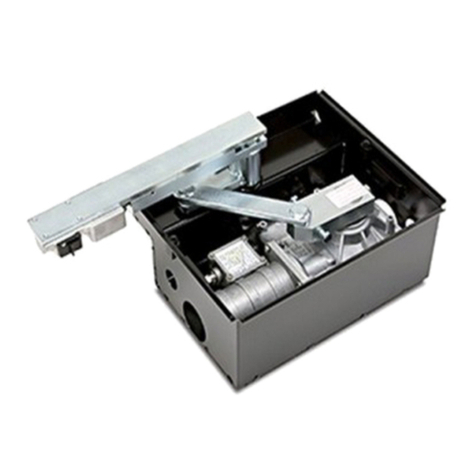
Cardin Elettronica
Cardin Elettronica 800/HL2524ESB instruction manual
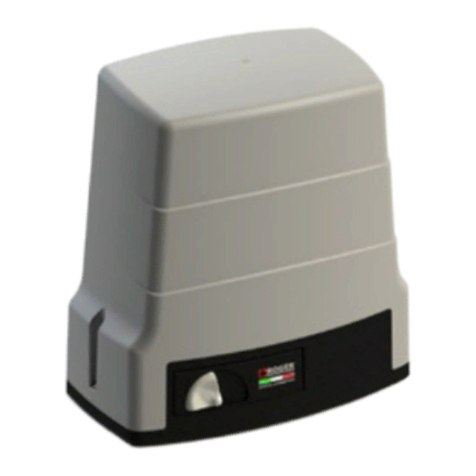
Roger Technology
Roger Technology B70/1DC quick start
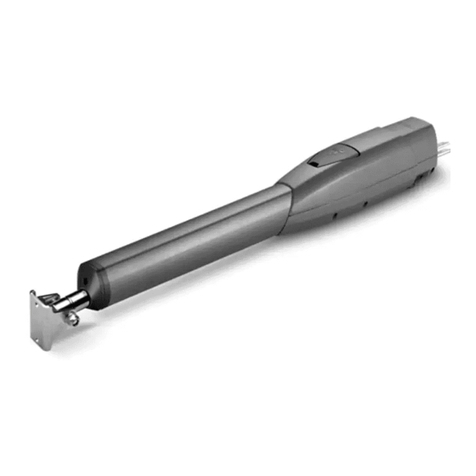
CAME
CAME ATS-S3 Quick setup guide
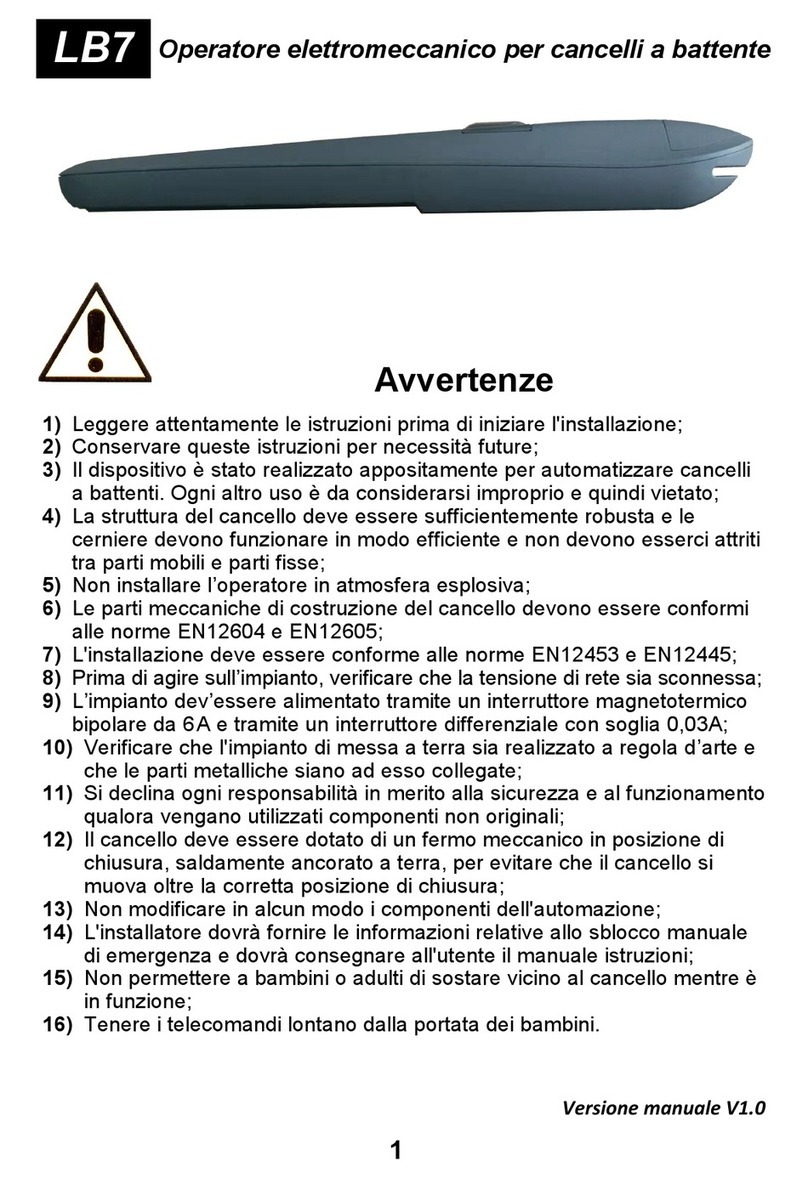
Leb Electronics
Leb Electronics LB7 manual
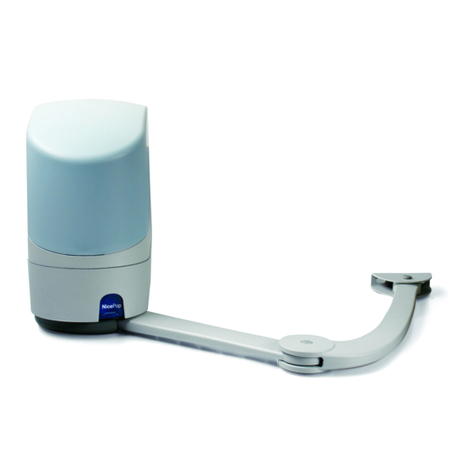
Nice
Nice POP PP7124 Instructions and warnings for installation and use
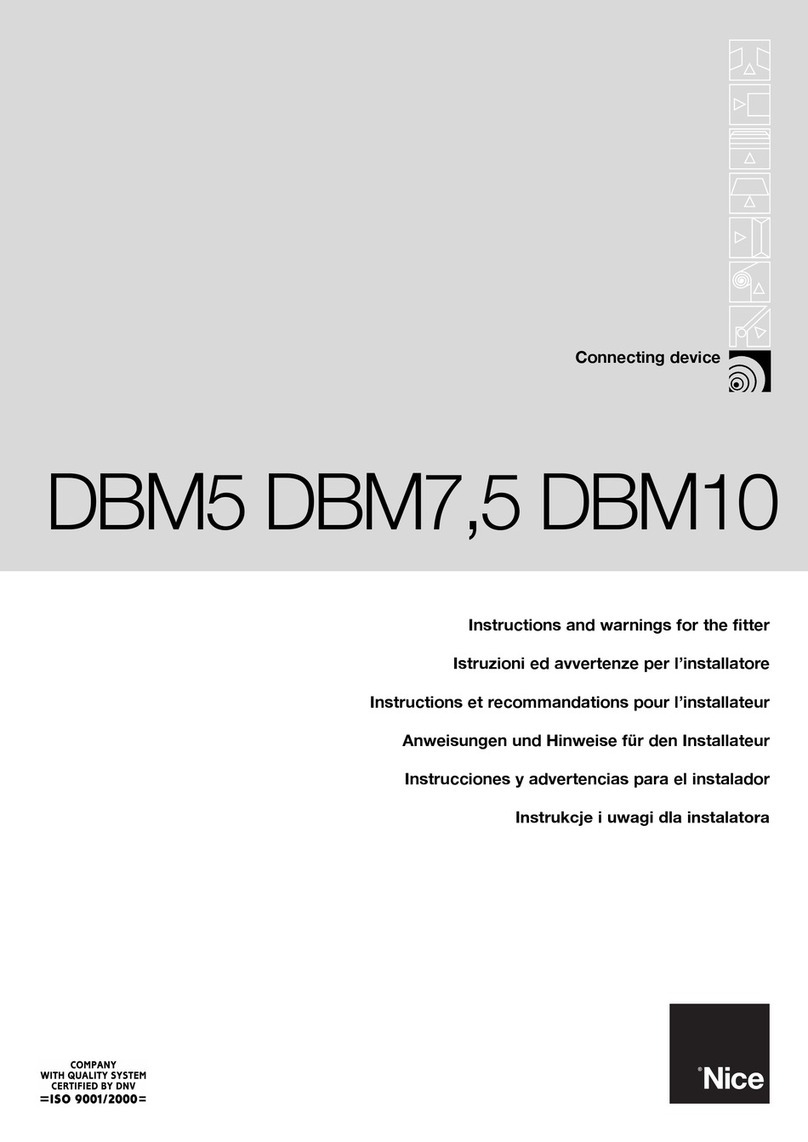
Nice
Nice DBM5 Instructions and warnings for the fitter
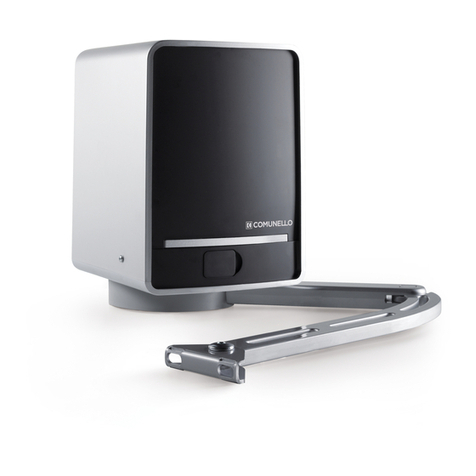
Comunello
Comunello CONDOR 220 Installation and user manual
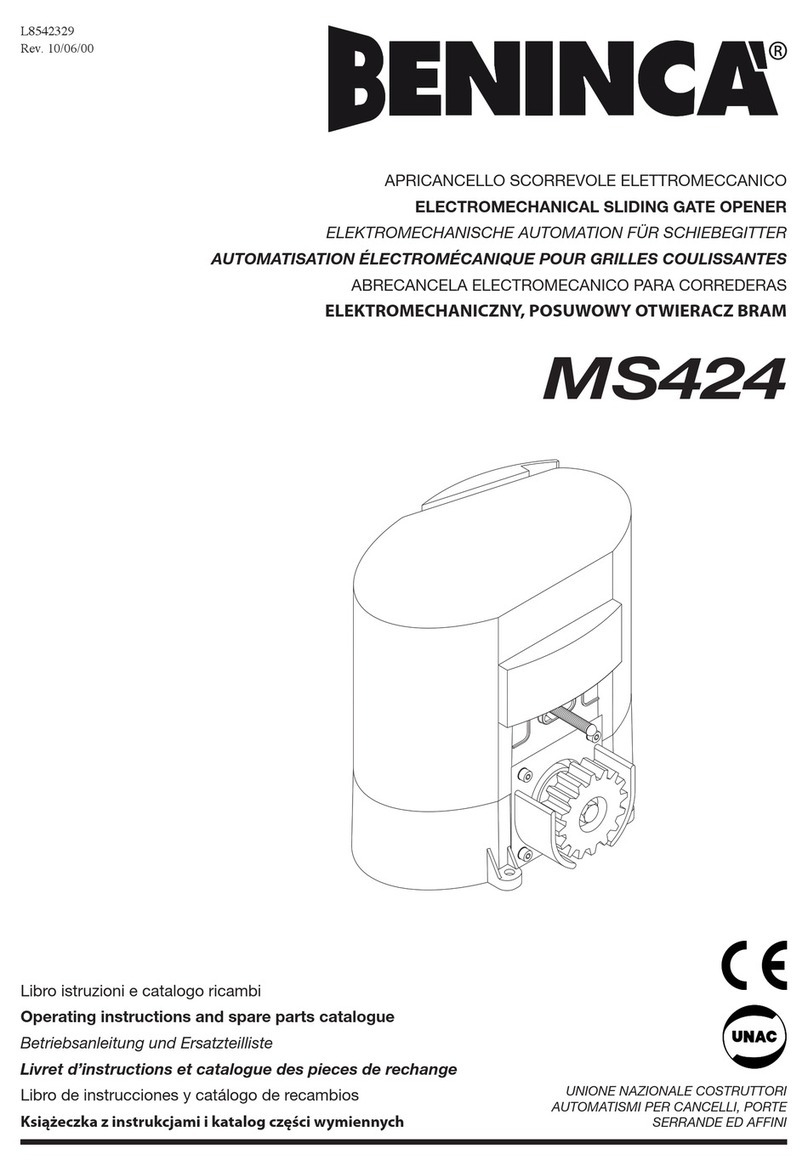
Beninca
Beninca MS424 Operating instructions and spare parts catalogue
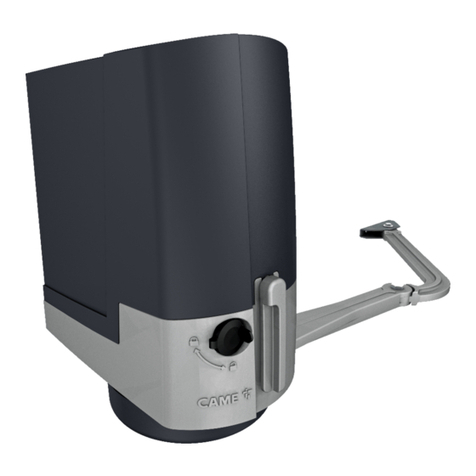
CAME
CAME FTX20DGC installation manual
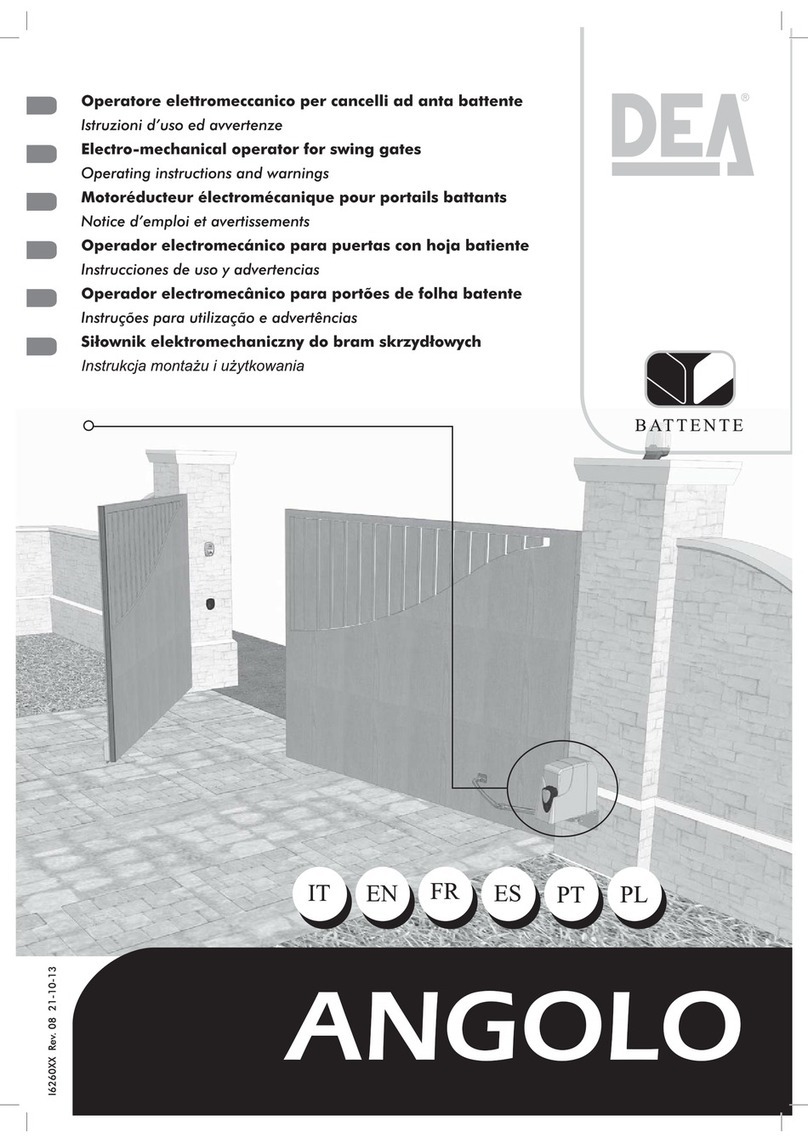
Dea
Dea ANGOLO Operating instructions and warnings
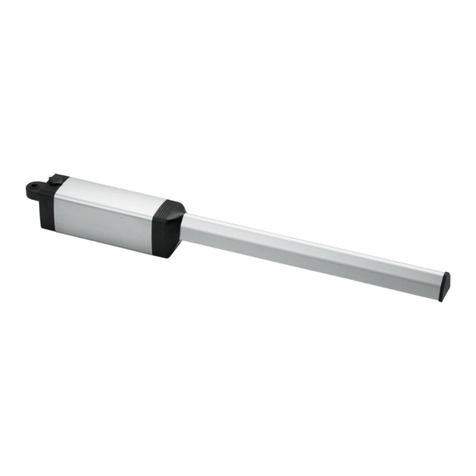
BFT
BFT PHOBOS N BT Installer's reference guide
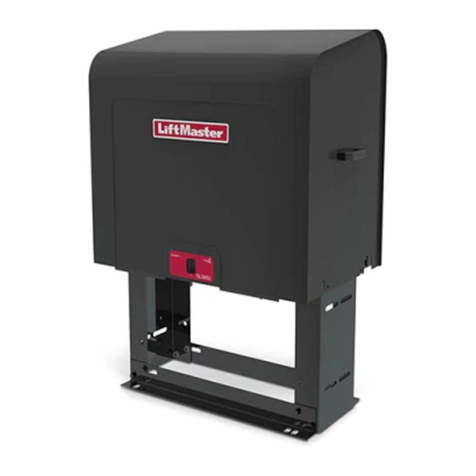
Chamberlain
Chamberlain ELITE Series Wiring diagrams
